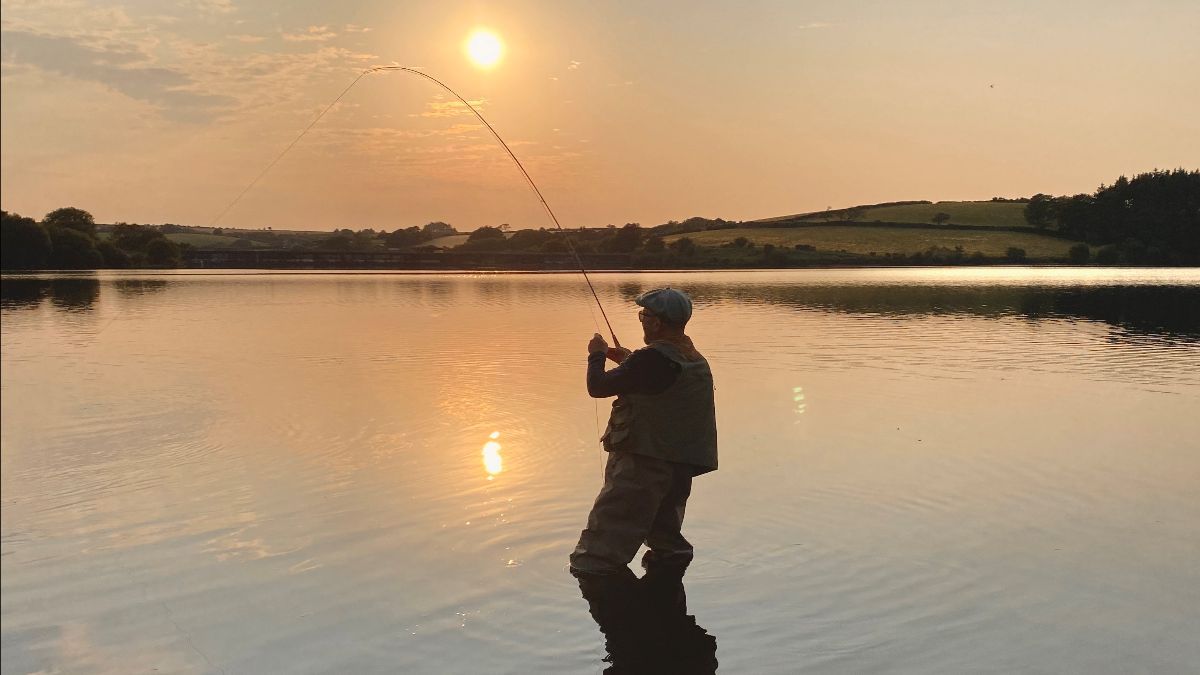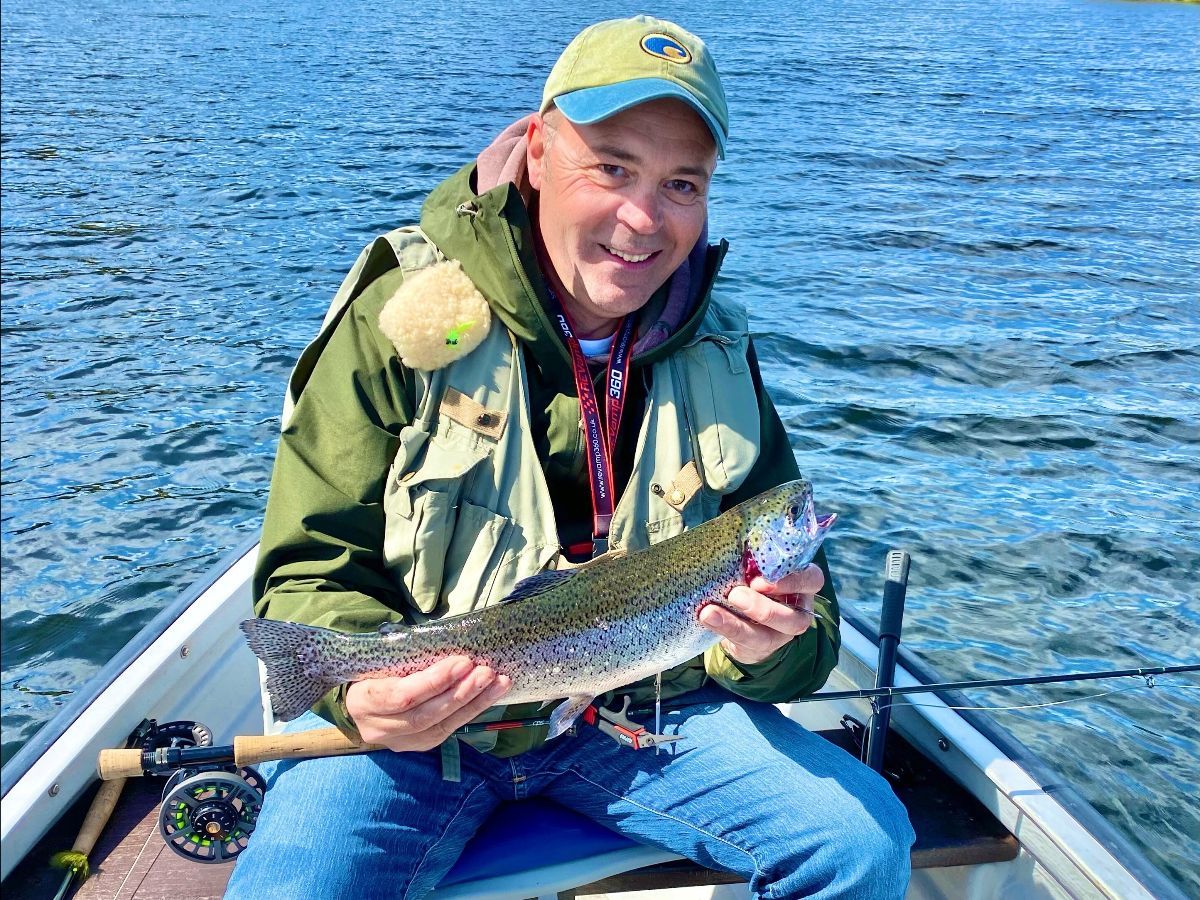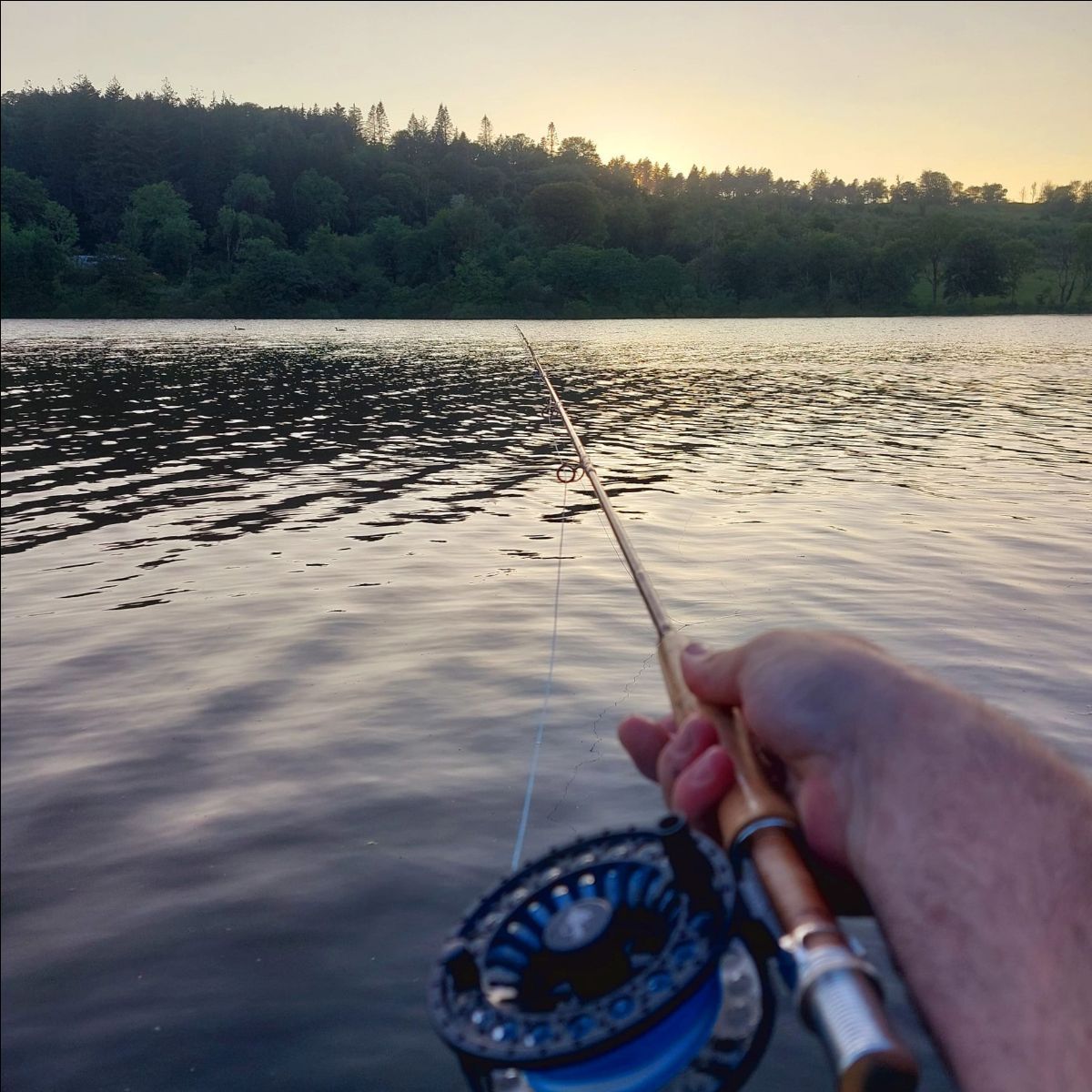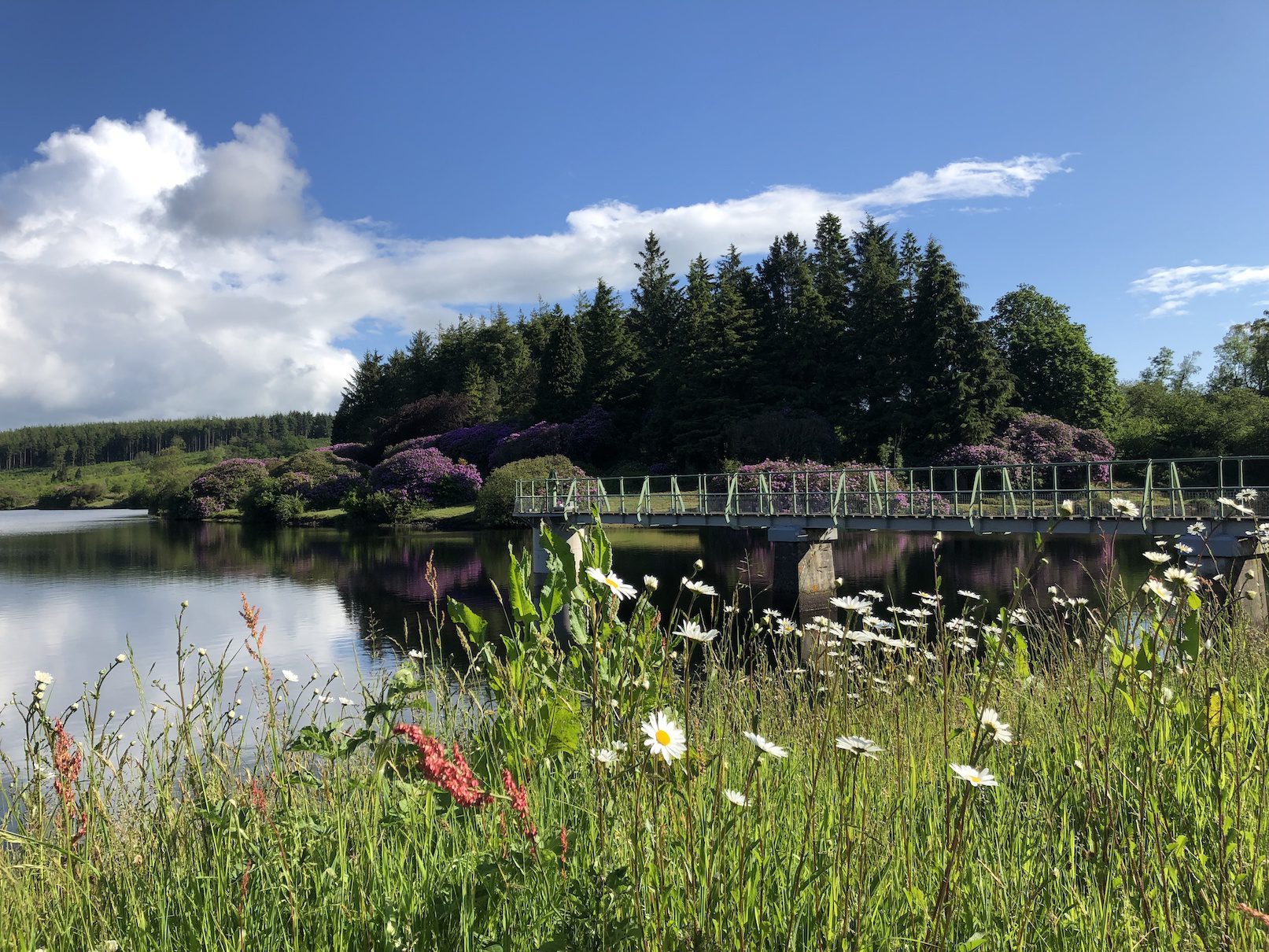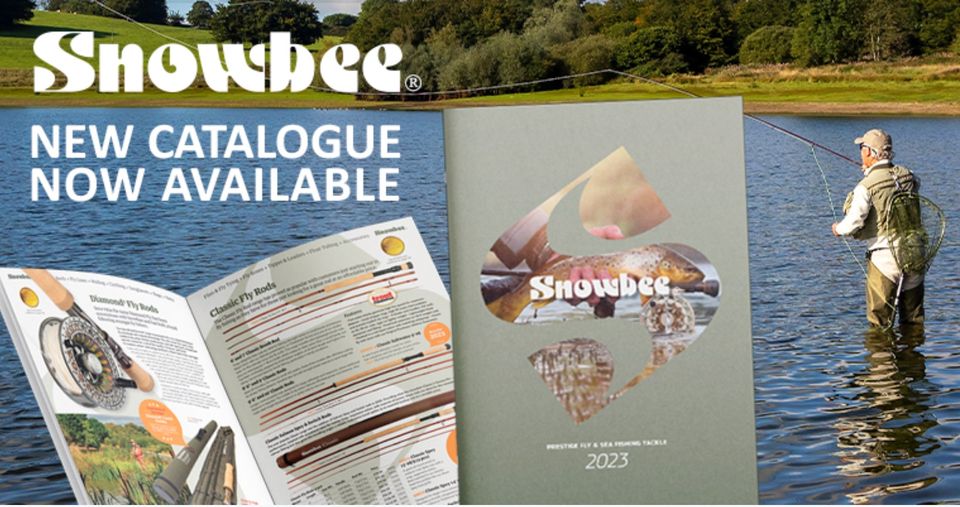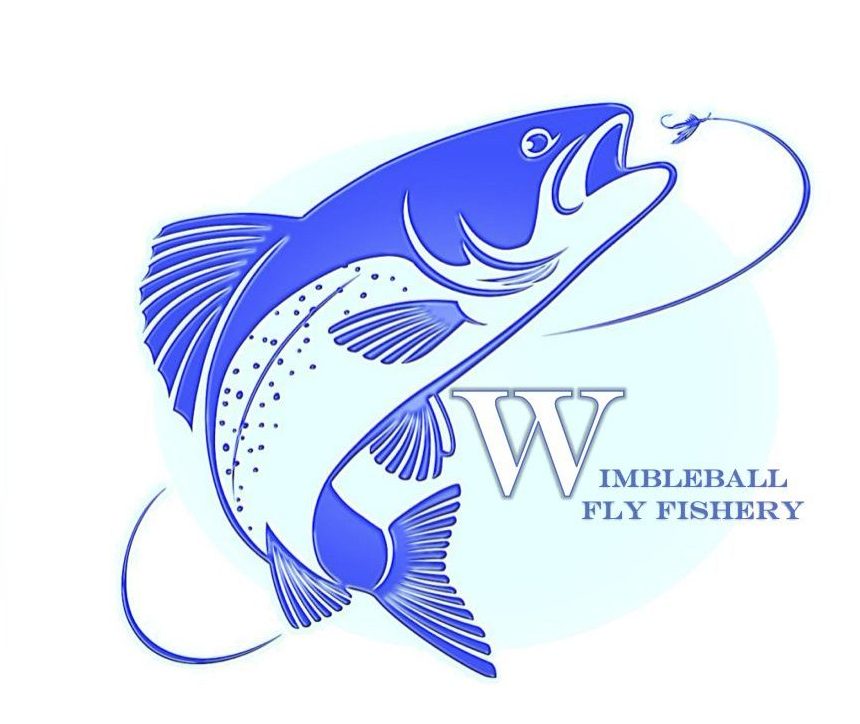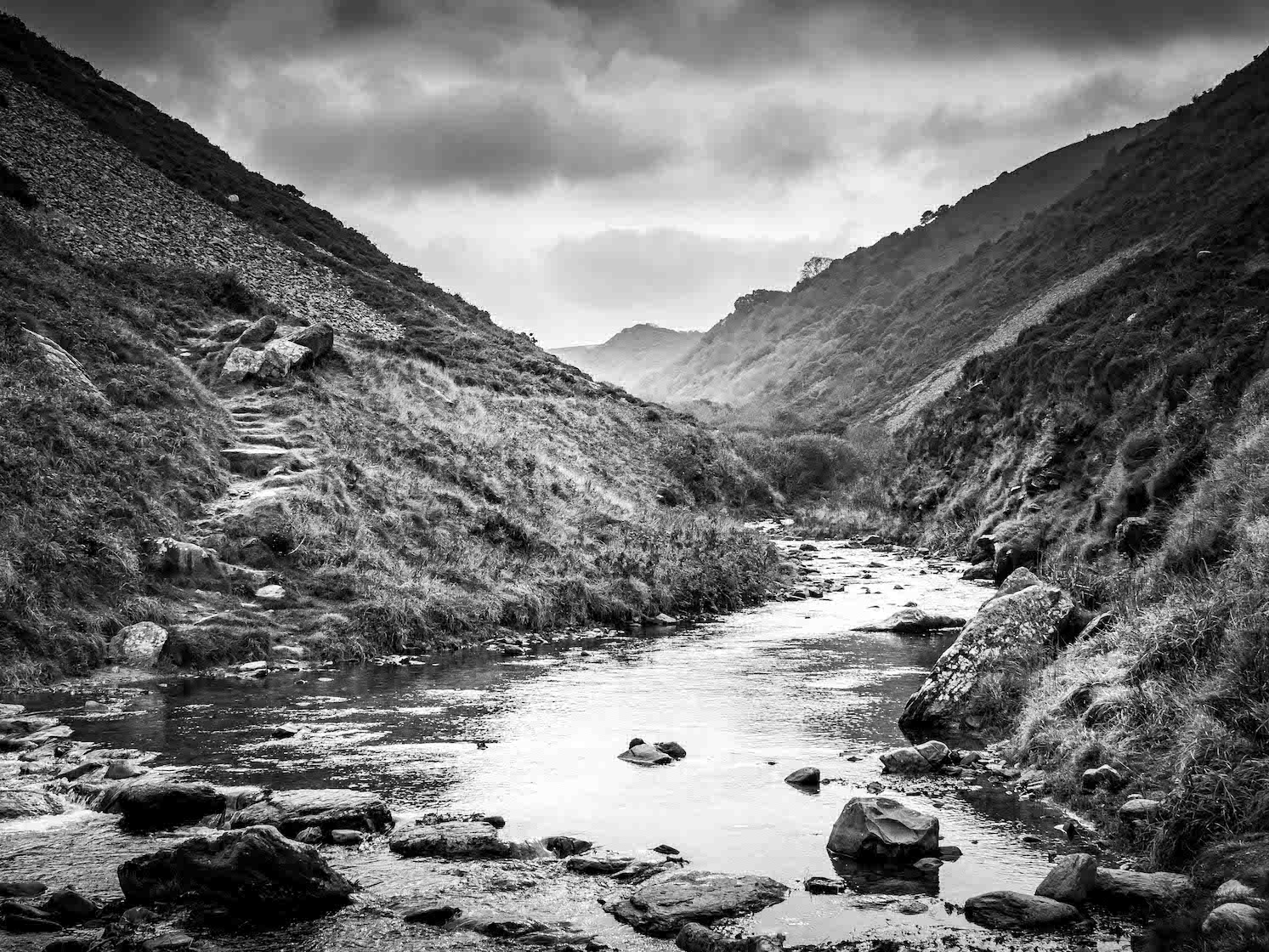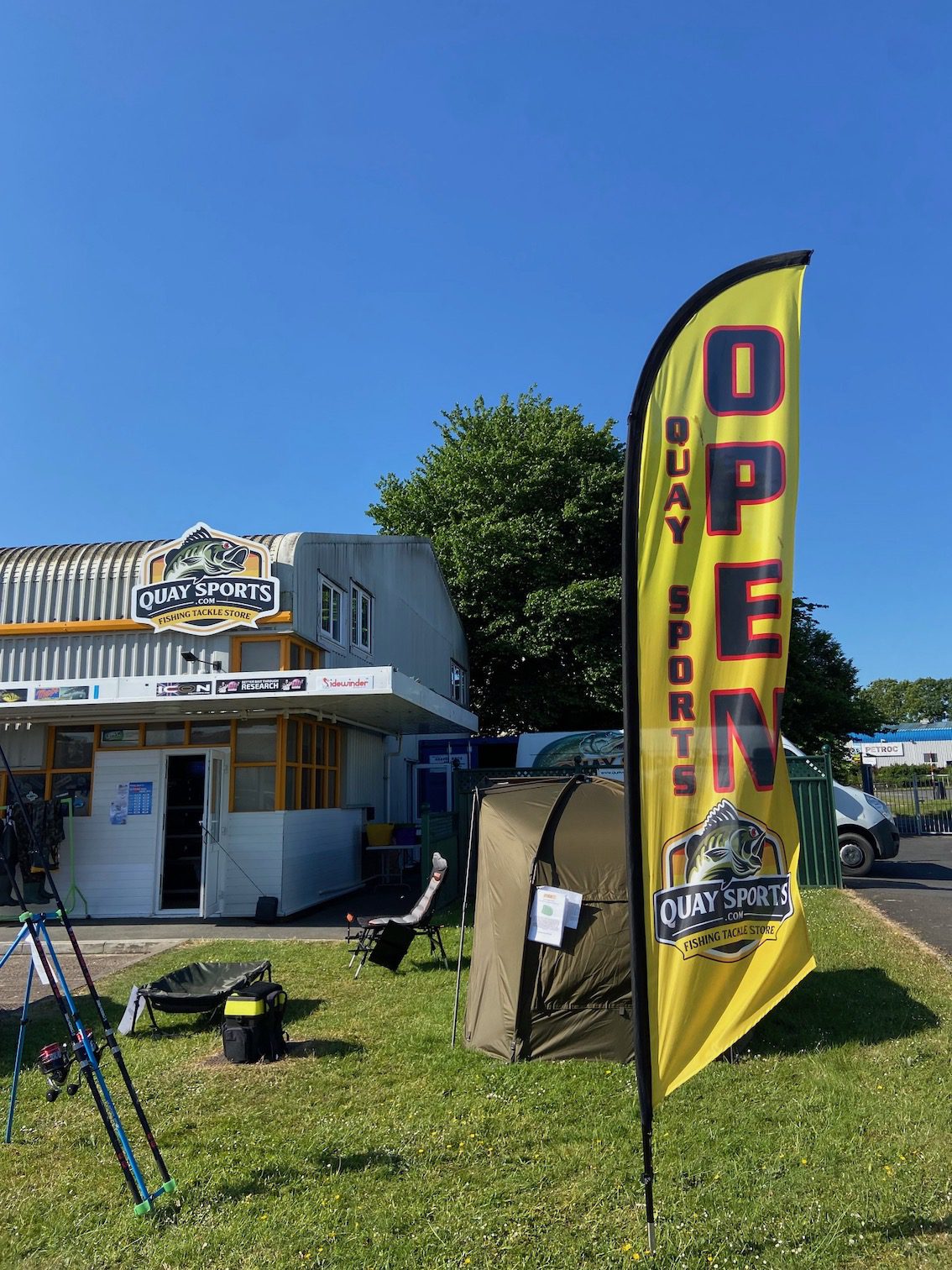|
Richard Wilsons Fish Rise – Summer Reading: Hemingwhy?
I am delighted to be able to publish Richard Wilson’s regular articles on North Devon Angling News. This months is close to my own heart with angling books and authors on the agenda.
https://fishrise.substack.com/p/summer-reading-hemingwhy
In Praise of Negley Farson
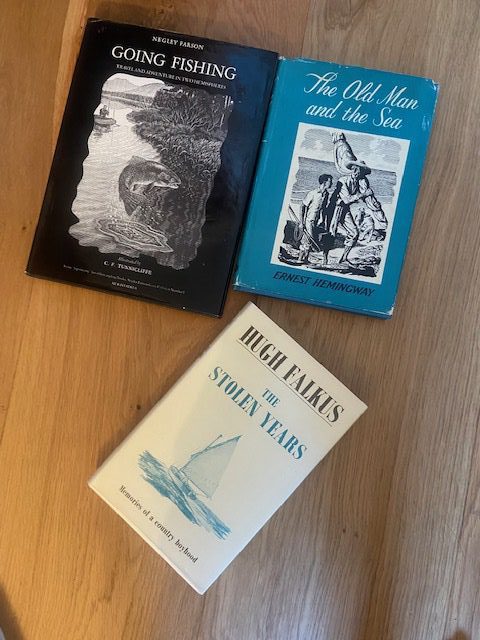
It’s that time of year again – summertime, holidays, excitement! I can hardly contain my inner grouch. Everything is a Buster … bonk-, bunny-, block- and so on. Book lists proliferate, making it clear that a lot of people only read on a beach (or at Christmas).
I think beaches are for avoiding and Christmas is for grumbling. Reading, on the other hand, is one of life’s great pleasures and needs no encouragement. Just do it.
This summer my off-the-beach bugbear is Hemingway and can be summed up in a single word: Why?
For a growing number of people it takes 3 sentences to explain him: “He was selfish and egomaniacal, a faithless husband and a treacherous friend. He drank too much, he brawled and bragged too much, he was a thankless son and a negligent father. He was also a great writer,” Prof Angela O’Donnell. Or you can have it in one: Great writer, shame about the man.
In recent years Hemingway’s character and grand-standing private life have taken a battering. Now, amidst the wreckage of character assassination, just the mighty wordsmith is left standing: Hemingway the Great Writer.
Well, maybe. Back in the heyday of hard-living literary narcissists, Hemingway had rivals. Among them was Negley Farson, an all-American adventurer, iconoclast, much-loved author, arms dealer, star foreign correspondent, fly fisher, sailor and raging alcoholic who ended his days in oblivion (drunk in rural England).
When both men died in 1960/1, Hemingway ruled the roost. Not now. Online, Farson’s Going Fishing is out-selling Hemingway’s Big Two-Hearted River by 4:1. This is an unreliable snapshot taken as I write this, but it’s well deserved. And while students buy Hemingway because they must – he’s on the syllabus – people read Farson because they want to. They do it because Going Fishing is one of the finest fishing books ever written and because Farson’s non-fishing books, once best sellers, are also on a bounce.
Farson was a glorious, swaggering misfit. Born in 1890 and raised in New Jersey by his grandfather, a cantankerous Civil War general, he lived for writing, drinking, travelling and fishing. And then again.
He was a First World War pilot for the British and then headed to Russia for the Revolution as an arms dealer. He was a rock star among American foreign correspondents back when foreign correspondents were household names, interviewed Hitler and reported from Germany as a Nazi mob stormed the Reichstag and felled German democracy. He witnessed Ghandi’s arrest by the British, was there to see John Dillinger’s corpse and, in-between times, there were Franco, Mussolini and global travel by boat, donkey and on foot.
He modestly billed his 1942 ‘Going Fishing’, as “just the story of some rods and the places they take you to.” It arrived, as only a Farson book could, with a review by fishing writer and fighter pilot Hugh Falkus. This might seem routine, but Falkus was incarcerated in Oflag IV-C, better known as Colditz; the prisoner-of-war camp where the Nazis locked up Allied troublemakers. ‘Going Fishing’ got into Colditz.
Farson drank Hemingway under the table, partied with F Scott Fitzgerald and confessed “I would never have believed it if anyone had told me so; but even the sight of a nude girl at the piano was beginning to pall.” More Hemingway than Hemingway you might think, and you’d be right.
Yet Farson is cursed by Hemingway’s shadow. Even his biography was patronisingly titled “Almost Hemingway”. This was as undeserved as it was offensive and wrong; Farson was the real deal while Hemmingway was striking a pose.
Both men were headstrong and deeply flawed characters who learned their craft in newspaper journalism. Hemingway picked up his minimalist ‘Iceberg Theory’ of writing as a junior reporter at the Kansas City Star. The paper’s newsroom stylebook (a feature of newsrooms worldwide) laid out a modest set of rules which I’ll rehash briefly: Write stripped-down sentences using Anglo-Saxon words. Take care with adjectives because they can reveal more about the writer than the subject. For a modern take on this see the Economist Style Book, available from Amazon and good bookstores. These rules are timeless and are as true today as they were then.
It’s also a long and well-trodden path. Here’s another former journalist: “We shall fight on the beaches, we shall fight on the landing grounds, we shall fight in the fields and in the streets, we shall fight in the hills; we shall never surrender.” Only Churchill’s last scornful word is French. Read it out loud and Google the speech for a masterclass.
Churchill’s words are as fresh now as they were in the darkest hours of the early 1940s. Likewise, Farson’s writing still leaps effortlessly off the page with the direct, no-nonsense clarity of a celebrated newsman honed on the Chicago Daily News, then a world-leading newspaper orbiting high above the Kansas City Star.
Yet, in contrast to Farson and Churchill, Hemingway’s writing can sound pretentious (a French word, of course) to modern ears. For example, the grating and self-indulgent repetitions:
“The trunks of the trees went straight up or slanted toward each other. The trunks were straight and brown without branches. The branches were high above.”
The Big Two-Hearted River
For modern readers, Hemingway has lost his fizz. Much of what once seemed innovative is now tired, and those repetitions wouldn’t have passed the sub-editors’ desk in Kansas.
Then there’s the image: Hemingway’s projected mid-life persona was aspirational for the age he lived in. But, nowadays, strong storylines and tight prose amount to nothing set against all those gloating pictures. The great white hunter, the slaughtered Marlin and machine-gunned shark are seared into our collective psyche. He’s the journalist who claimed to have killed German prisoners of war. That would be murder. So a new generation of readers think he’s the braggart poster boy for toxic masculinity and misogyny. That some of his writing is still great doesn’t matter. A trashed image trumps everything and that this is self-inflicted makes it worse.
So, if you’ve never read Negley Farson, please do. For the many who have, including me, Going Fishing is the finest autobiographical fishy book in a crowded field. His friend, F Scott Fitzgerald, confessed that while he had relied on imagination for compelling stories, Negley could simply draw on life.
Farson is still a great writer with an indelible legacy. And he’s long overdue a return to the limelight.
So, to whoever writes his next biography, the correct title is “Better than Hemingway”.
“Farson lived each day as if it were a door that needed kicking in.“
Rex Bowman, co-author of “Almost Hemingway”, getting it right.
Why Hemingway? I don’t know – no good reason I can think of. But I can tell you why Farson: He’s a great writer who has passed the test of time.
For more of Richards wisdom click on the link below
https://fishrise.substack.com/p/summer-reading-hemingwhy
My own thoughts on books and authors.
Reading and writing are fascinating topics and I try to do a bit of both. Books are wonderful and good ones do indeed stand the test of time remaining in print and relevant for decades or even centuries. The rapid expansion of the internet and digital produce caused concern that the book in its hardback or paperback form had had its day. Fortunately, the book in its printed form is going strong and looking at the shelves in Tesco and Waterstones is testament to the longevity of the books and readers preference for something tangible and tactile.
When I write I try to entertain, inform and record memories or moments in time. Angling authors abound and I have my favourites and these are perhaps those who manage to capture the essence of angling in prose that flows easily from the page. Choosing favourites is almost impossible but Chris Yates, H.T. Sheringham and BB have to be close to the top of my own list. Richard Wilson touches upon the characters and what type of people they were. To some extent this is determined by their place in society. Hemingway, Farson, Zane Grey, Hugh Falkus and Mitchell Hedges are all author’s that I would guess were rather arrogant larger than life chaps who liked a beer or two and lived fast and loose. The typical swashbuckling movie idol of the time? Chris Yates, BB and H.T. Sheringham are writers of a more genteel and idyllic prose who paint a different picture with their pen. To link waters with the psychological profile of the author is perhaps a little deep but could however make for a fascinating read.
Wayne Thomas
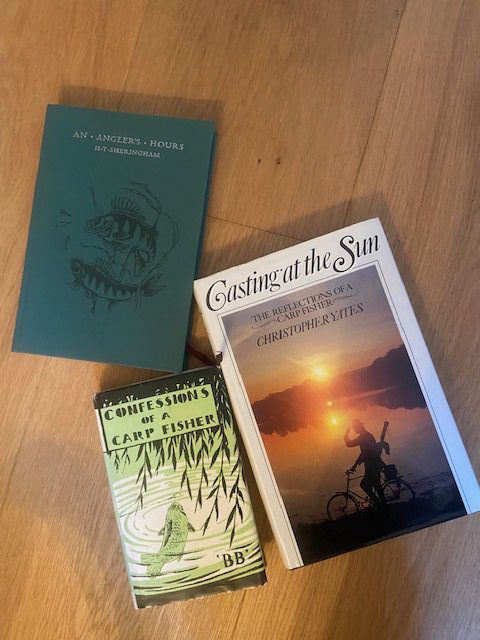
South West Lakes Trout Fisheries Report June 2023
South West Lakes Trout Fisheries Report
June 2023
June saw a dramatic rise in water and air temperatures, with plenty of bright sunshine and very little rain, with the trout retreating to deeper waters on many of the reservoirs, and in many cases not so eager to feed, which made the fishing challenging, and anglers needed to be flexible in their approach. Boat anglers enjoyed the best of the sport.
Fishing
Kennick – The reservoir has started to fall again, down to 91% capacity by the end of the month. In spite of plenty of surface insect activity (beetles and sedges), generally the fish stayed in the deeper water, and intermediate or sinking lines fished with lures, blobs and boobies often produced the best results, although nymphs (Damsels, Dawl Bachs, and Buzzers) fished on floating lines did produce good results on some days. Apart from the central deeper water fished by the boats, bank anglers managed to pick up fish at Smithacott, Clampits, the Lawns, Jan’s Rock, and the deeper water by the dam. Simon Vowles and Andy Sterrick (from Exeter) enjoyed a great day’s boat fishing, catching twenty fish between them using a Coral Booby, Cats Whisker Booby, and a Coral Blob on fast sinking lines and short leaders tight to the bottom, using a slow figure-of-eight retrieve. Brian Parry (from Newton Abbot) caught six fish to 2lb 8oz using a Cats Whisker on a sinking line.
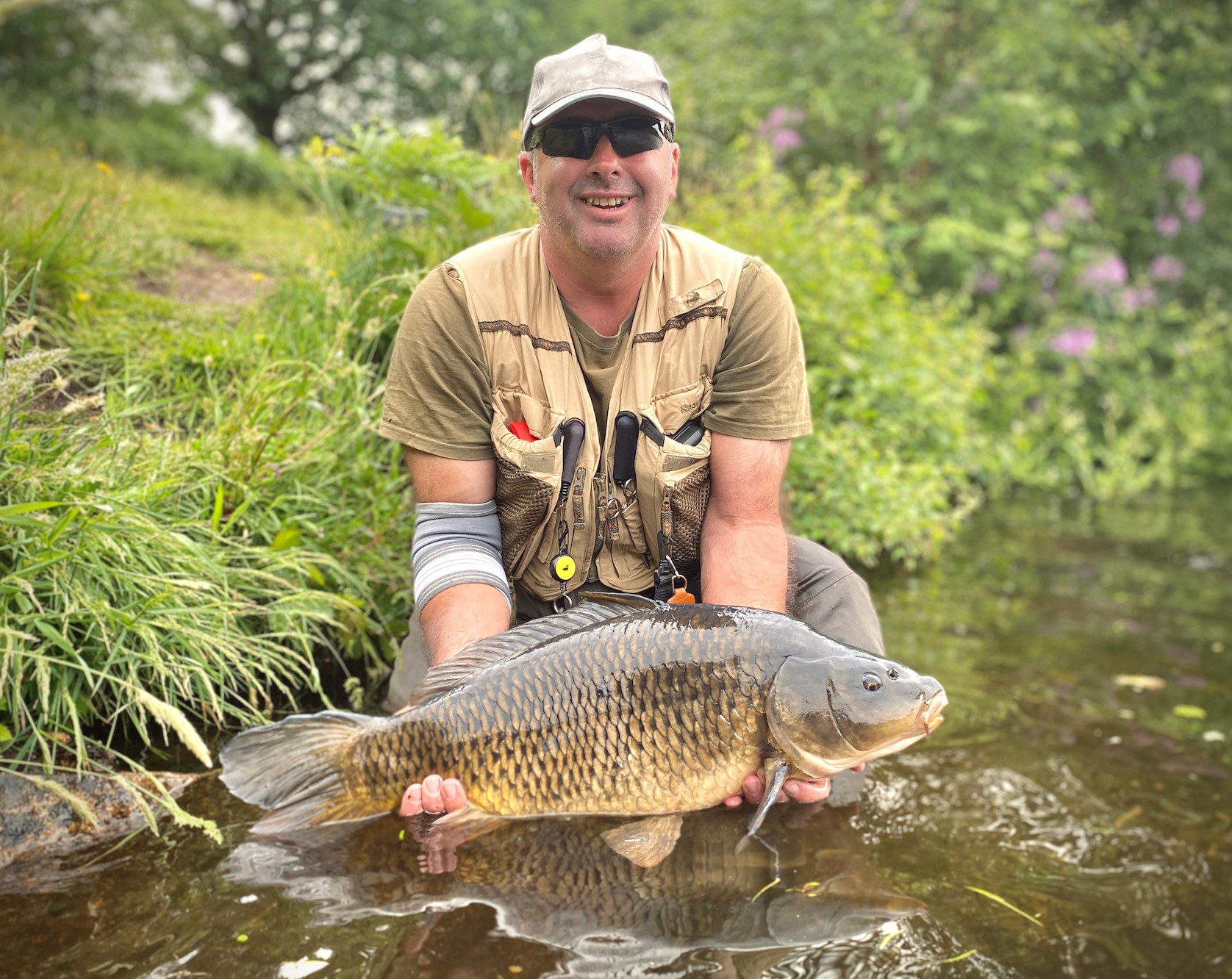
Siblyback – The fishery has now dropped to 92% full, and with plenty of insect activity (Beetles, Damsels, and Sedges) the fish continue to rise freely to feed. Early in the month anglers averaged 3.5 fish per rod, although this fell off as the month progressed with warmer brighter conditions. Two Meadows, Crylla Bay, Stocky Bay, and the North Shore produced the best sport, with plenty of fish being taken on floating lines and dry patterns (Coch-y-bondhu, Bibio, Shipmans Buzzer, Black Hoppers, and Deer Hair sedges), with sub-surface fish being caught on Montanas, Buzzers, and Kate McLarens. Fourteen year old Johnny Moesel (from Okehampton) enjoyed a superb day’s sport, catching nine trout, including a rainbow of 3lb 5oz, another at 3lb, and a lovely wild brownie of 1lb 9oz, using a floating line with a Coch-y-bondhu on the point and a hopper on the dropper, casting to rising fish.
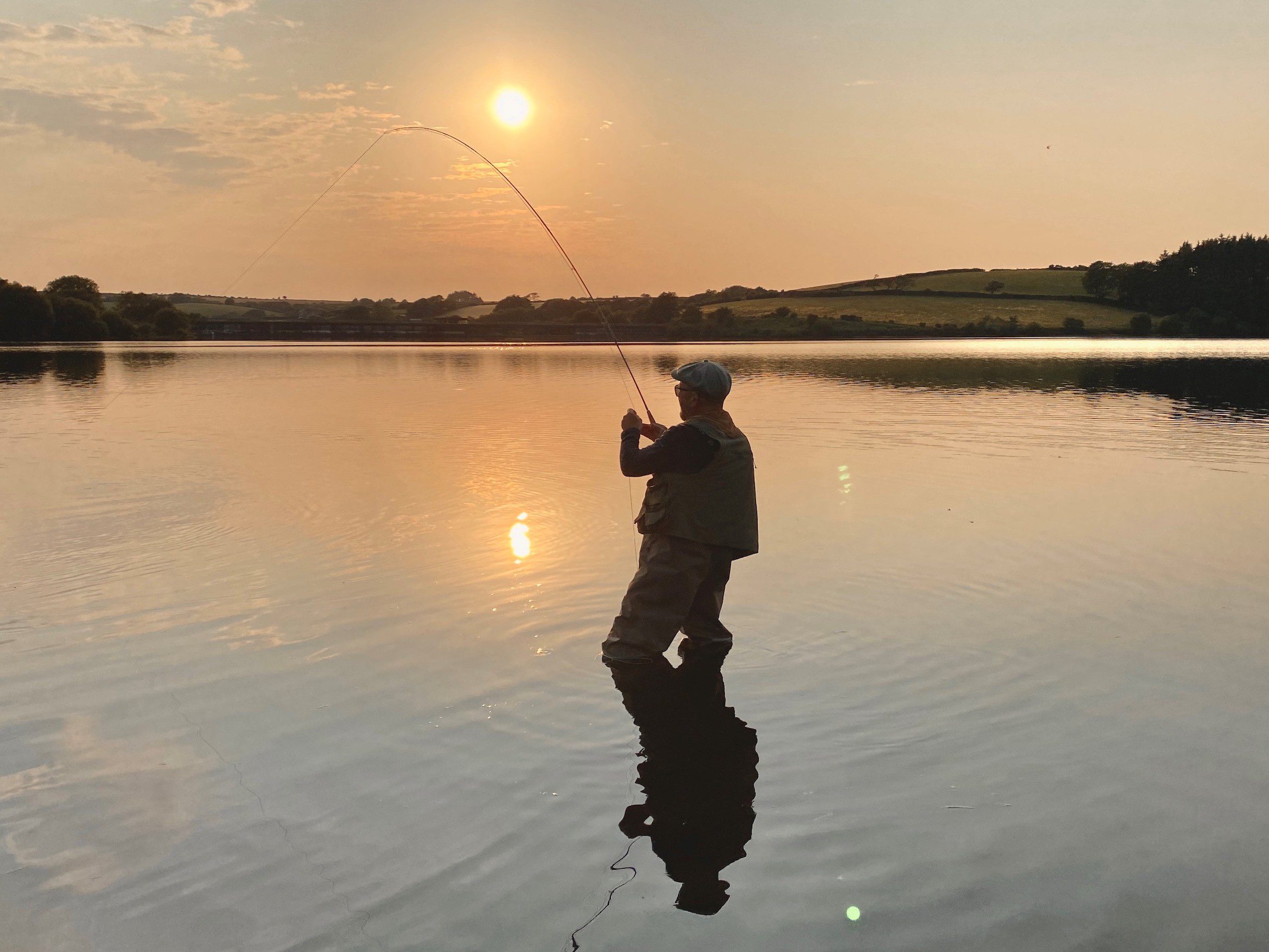
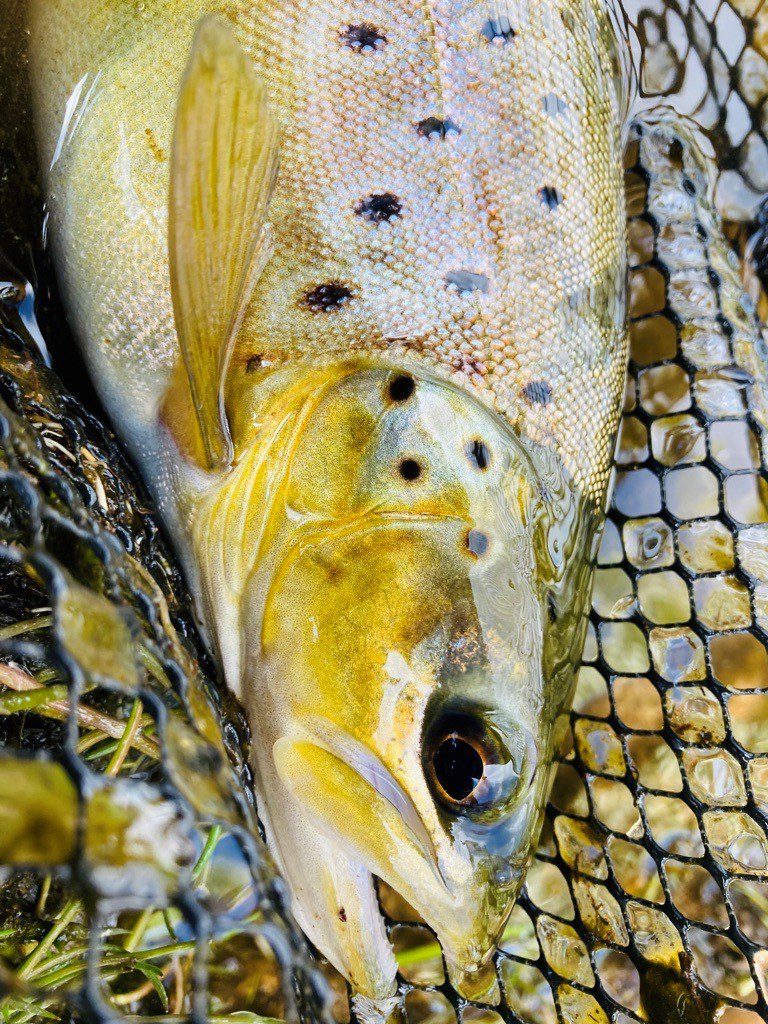
Burrator – During the first two weeks of June anglers averaged two fish per rod, but this tailed off as the month continued. Back Bay, Longstone, Sheepstor, and Pig Trough banks produced the best sport, and with plenty of beetles on the water as well as a good evening rise, fish were feeding eagerly from the surface. Floating lines with a slow figure-of-eight retrieve or washing-line tactics proved to be the most effective methods, with anglers catching fish on a variety of dry patterns (Hoppers, Sedges, Beetles, and Grey Wulff), while sub-surface feeders took Buzzers, Damsel Nymphs, Montanas, Diawl Bachs, and Invictas. Chris Arscott caught a beautiful 3lb 8oz brown using a Diawl Back, floating line and slow retrieve fishing early in the evening, while Roger Prout caught a 3lb rainbow using a Black Top Hat Topper. Simon Stokes (from Horrabridge) caught five rainbows to 2lb 8oz along with one brownie, using a washing line of Buzzers, Crunchers, and rubber beetle.
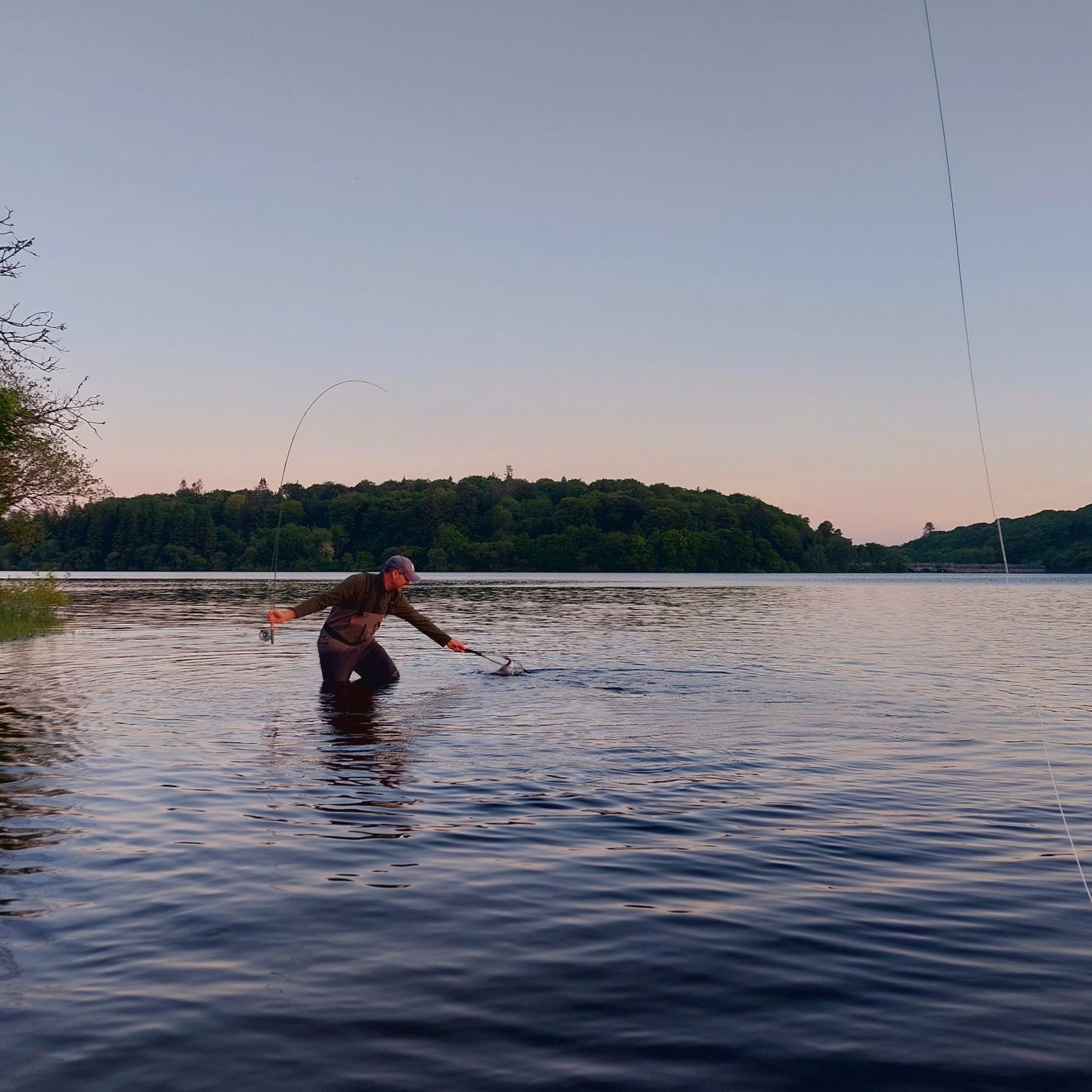
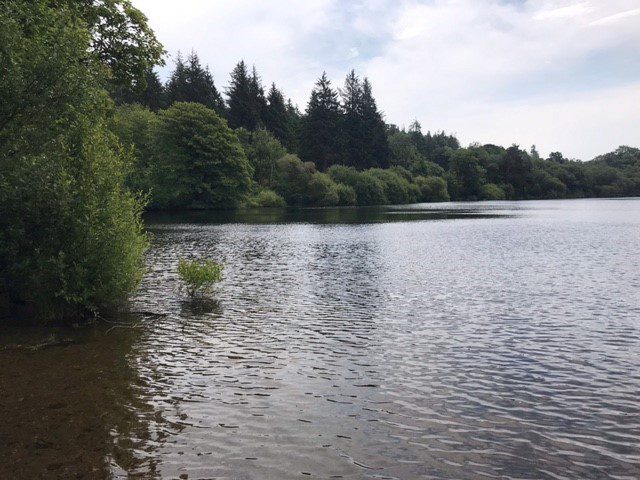
Stithians – Stithians fished fairly consistently throughout the month, with anglers averaging 2.3 fish per rod; fish were well spread out around the fishery, with anglers enjoyed particular success at Mossops, Yellowort, Goonlaze, Hollis Bank and the deeper water by the dam. With plenty of beetles being blown onto the water, fish were keen to look up to feed, and a selection of dry patterns caught fish (Beetles, Sedges, Black Gnats, Hawthorns, and Hoppers); otherwise, sub-surface feeders were taken on nymph patterns (Diawl Bach, Montanas, and Damsels) fished with a floating line. Roger Clark (from Truro) caught four rainbows to 4lb (best fish of the season so far). Simon Peters (from Cusgarne) enjoyed a couple of successful sessions, catching eight rainbows to 2lb and a couple of 10oz browns using dry beetles on one visit, and five rainbows to 2lb on another.
Fernworthy – With beetles in the air, there have been plenty of rising fish throughout the month at Fernworthy, and anglers have averaged 2.3 fish per rod, mainly using a variety of black dry patterns (Hoppers, Hawthorns, Black Gnats) and beetle imitations. Fish have generally been between five and fifteen yards from the shore, with popular banks including Thornworthy, Potters Bank, Boathouse Bay, and the North Bank. Phillip Smith (from Lechlade) caught five browns using a Hopper pattern, while Paul Ackland (from Plymouth) caught 7 browns to 1lb 8oz using a dry foam beetle and pheasant tail nymph.
Colliford – The water level here started to rise, but then receded with the warm dry weather, and is now at 64% capacity; anglers fared well, averaging 4.2 fish per rod over the month, and with beetles about, plenty of floating line and dry fly action. Successful patterns included foam beetles, black hoppers, Bobs Bits, and sedge patterns, with fish well spread out around the fishery – best tactics are to keep on the move to cover as much water as possible, fishing close to the bank, as well as out over the deeper water. Rodney Wevill (from Launceston) enjoyed a successful evening session, catching eight browns on a floating line in the last two hours before dark; Nick Odle (from Looe) caught fifteen browns using a mixture of wets and dries; while Phillip Smith (from Lechlade) caught seven fish to 1lb, mainly on dries and a single hopper.
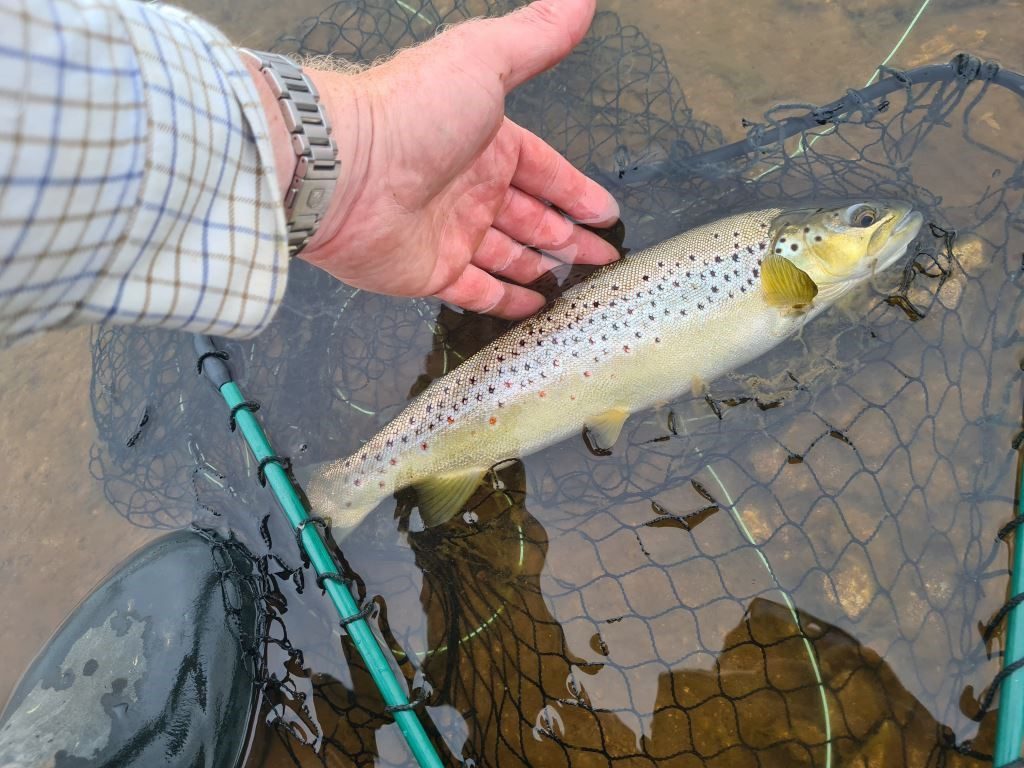
Roadford – Now down to 66% full, the fishing has been challenging at Roadford, with a few fish being caught from Davey’s Bank, East Bank, Goodacre Bay, and over the boils from a boat. There have been a few midge hatches, with the occasional rising fish, but anglers have had more success using intermediate or sinking lines with nymph and lure patterns.
Please see the Trust’s website (www.swlakestrust.org.uk/trout-fishing) for more information on buying tickets, boat availability and booking, and forthcoming events.
Barnstaple & District Angling Association – Mid season Report
B.D.A.A 27/6/2023
https://barnstapledistrictangling.co.uk
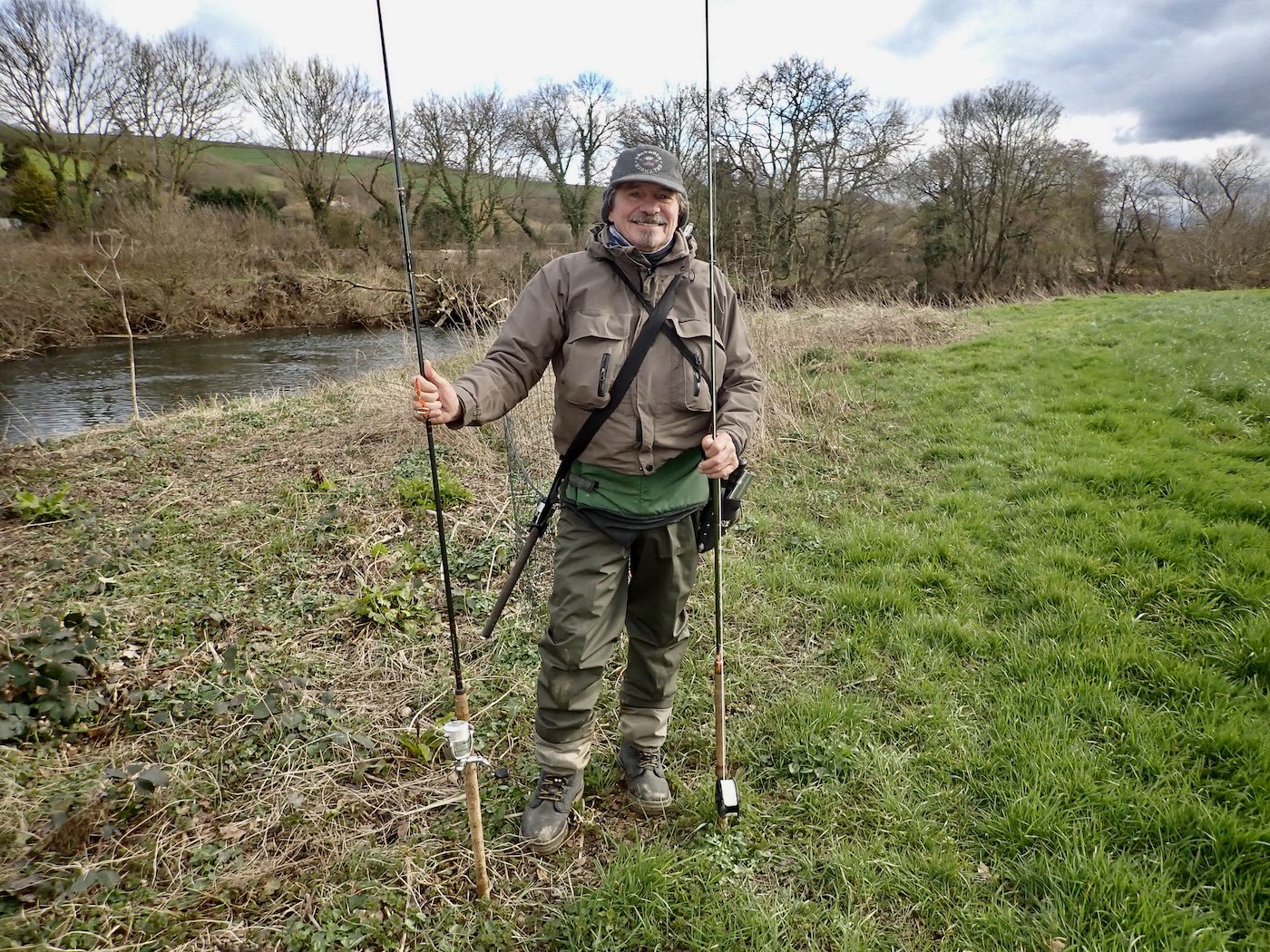
Many thanks to Don Hearn for allowing me to share Barnstaple and District Angling clubs mid-season report below.
NEWBRIDGE MID SEASON REPORT
After an exciting start to the season with several good fish taken and seen we are now, as last year, faced with extremely low water. The temperature was measured yesterday by the bridge at over 20 degrees and this of course can be threatening to migratory game fish. We have seen Salmon gasping on the surface and several casualties have been found. Some from mishandling, we think, but not by our members as far as we are aware. We are asking for restraint from salmon/sea trout angling during these drought conditions as any fish caught would be at risk of not recovering from the experience. You may have seen online that this is happening nationally and is disastrous for the species. We can but hope for rain. The Hall Estate up river from us has also asked beat holders for angling restraint until the water levels improve. Hopefully, as last year, we will get a decent run of fish when the rain finally comes.
We have now completed the new hut and after a bit of tidying of surrounding areas will soon be declaring it formally open! Hopefully this will last for many years and be a peaceful place to rest and shelter while watching the river pass by. This has involved a great deal of work from our volunteers but we all feel it’s worth it. The original hut was very substantial but in these changing times we couldn’t hope to compete. We are however proud of what we have achieved and hope it will serve its purpose for many years to come. With this downtime from angling at Newbridge work continues with strimming and clearing and if anybody has any suggestions for the beat they would be welcome. Also feel free to carry cutters etc and help yourself!
However, the restriction on the river doesn’t mean you can’t go fishing. One of the most popular options is fly fishing for Bass in the estuary. A greater challenge would be the Mullet. Both would give you a great scrap in lovely surroundings and well worth the effort. We do of course have course fishing at Aller pond which fishes well in summer with such deep water keeping temperatures down. Yet another quiet place to while away a few hours.
Whatever alternative you may find we look forward to getting back on the river when conditions improve and wish you, as ever, tight lines.
Don Hearn
Newbridge River keeper
My own comment :-
The low river levels as a result of prolonged dry conditions are a serious concern and if as is generally thought are a result of ongoing climate trends this does not bode well for the future. We all share the burden of potential climate disaster and need to consider how we should react. My own observations as an angler and conservationist are concerning. Indications that the natural world is in a bad place are all around. If salmon in the river are the proverbial canary in the mine then we should all be concerned.

Wimbleball – Days to be cherished
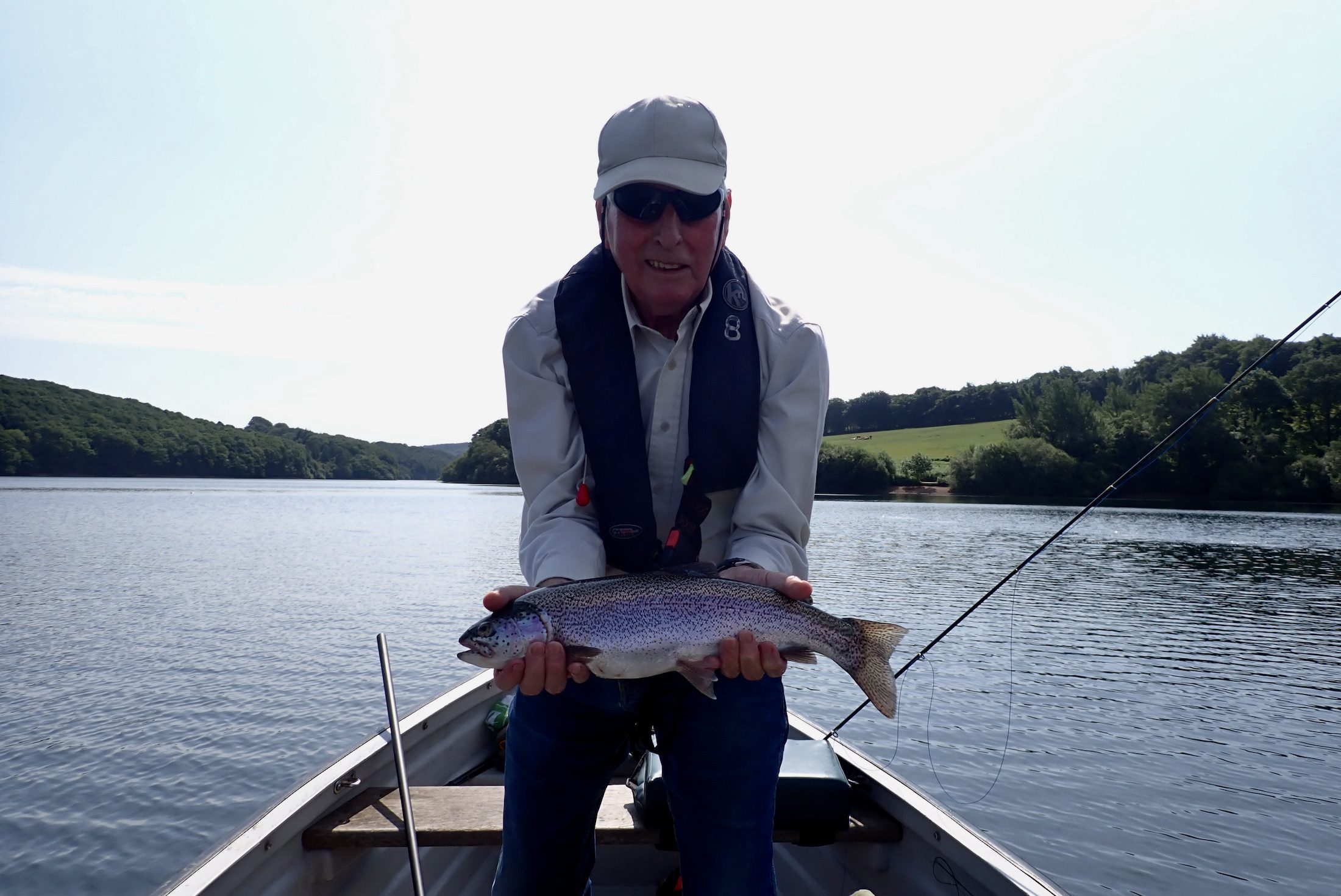
Wistlandpound Fly Fishing Club held their latest competition at Wimbleball Reservoir where Andre Muxworthy secured first place in difficult conditions boating a brace of rainbow trout totalling 4lb 10oz. I was runner up with a rainbow of 2lb 6oz. In the hot bright conditions, the trout had gone into the deep water close to the dam and were caught using fast sinking lines.
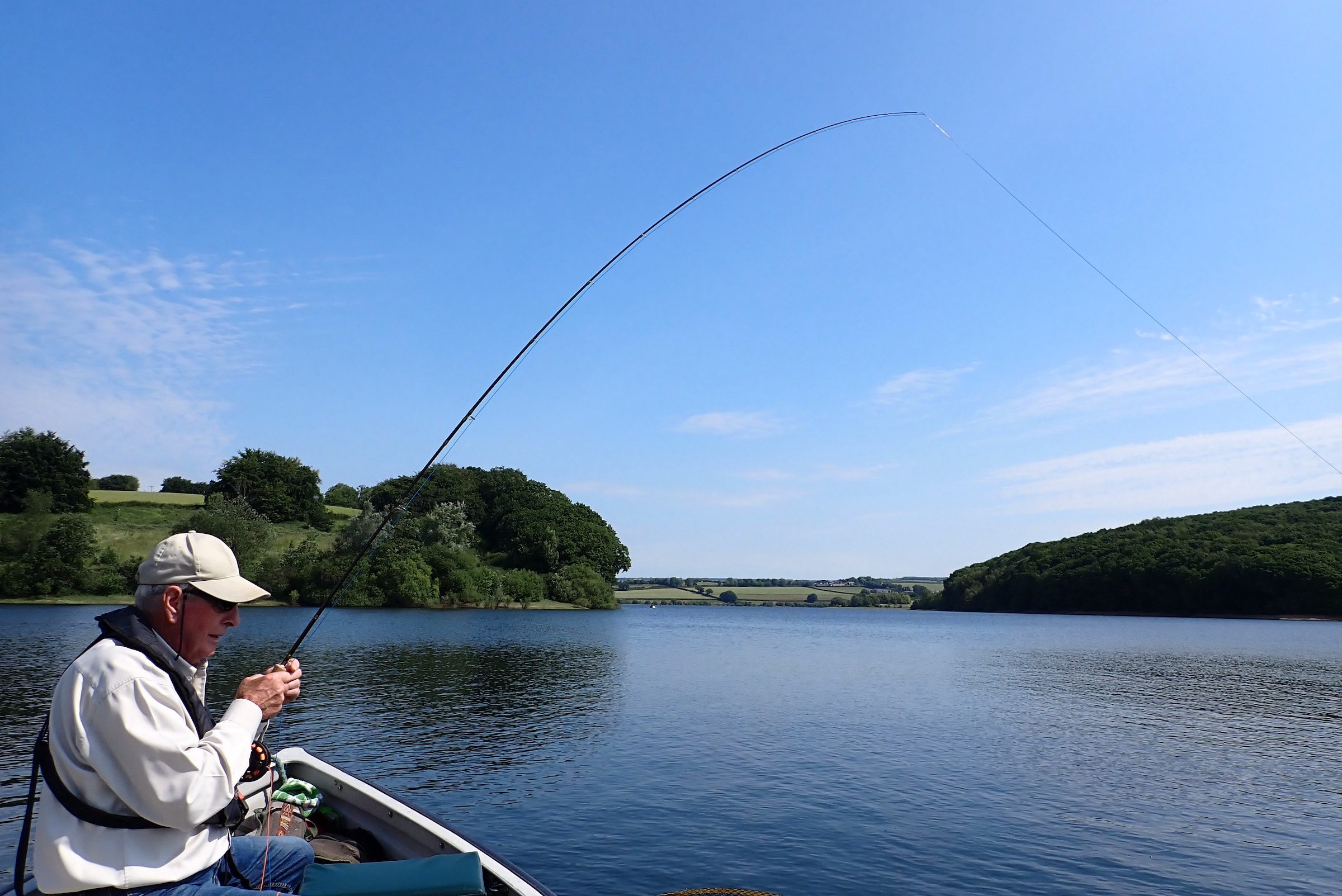
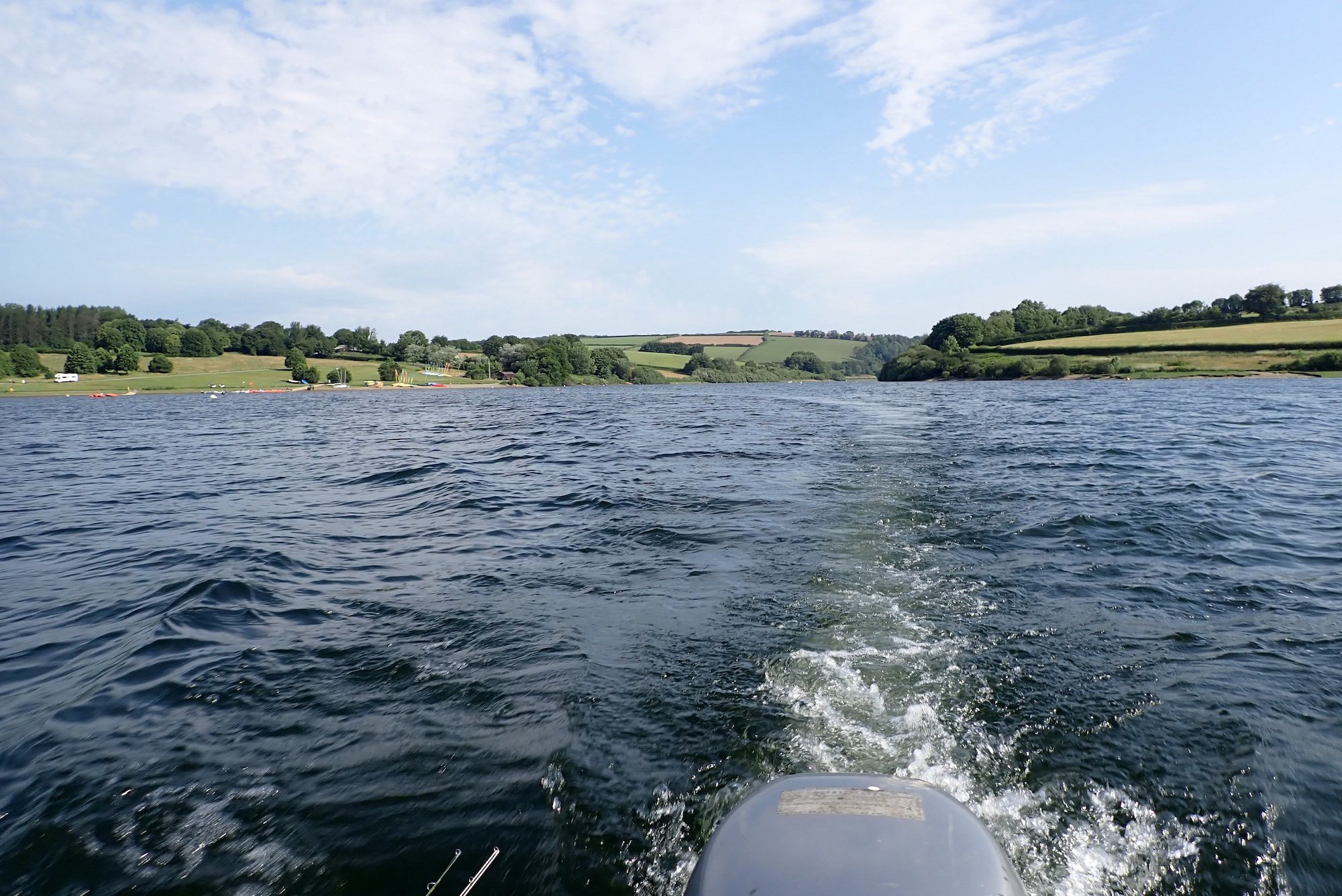
During the hot days of summer a boat is without doubt the best option on this large reservoir giving the opportunity to search various areas in search of the venues hard fighting rainbow trout and wild brown trout. In the heat of the day deep water is undoubtedly the best place to search with bright lures, blobs and boobys good tactics to employ. In the cooler evenings dry flies and nymphs can work well. Mid June saw some spectacular sport with trout feasting on beetles and mayfly. Whilst the long hot days of summer often prove difficult any day spent afloat on this beautiful water is to be cherished.
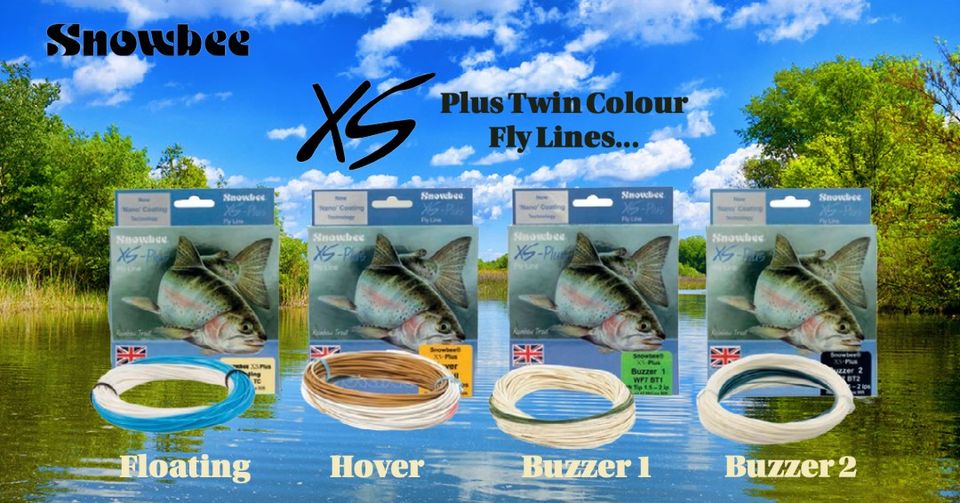
QUAY SPORTS CHARITY DAY
SONG OF THE STREAMS – Michelle Werrett
Song of theStreams
Michelle Werrett Photography by Robin Baker
Fishing and Conservation on Exmoor Streams
https://www.medlarpress.com/code/bookshop?store-page=Song-of-the-Streams-p547451092
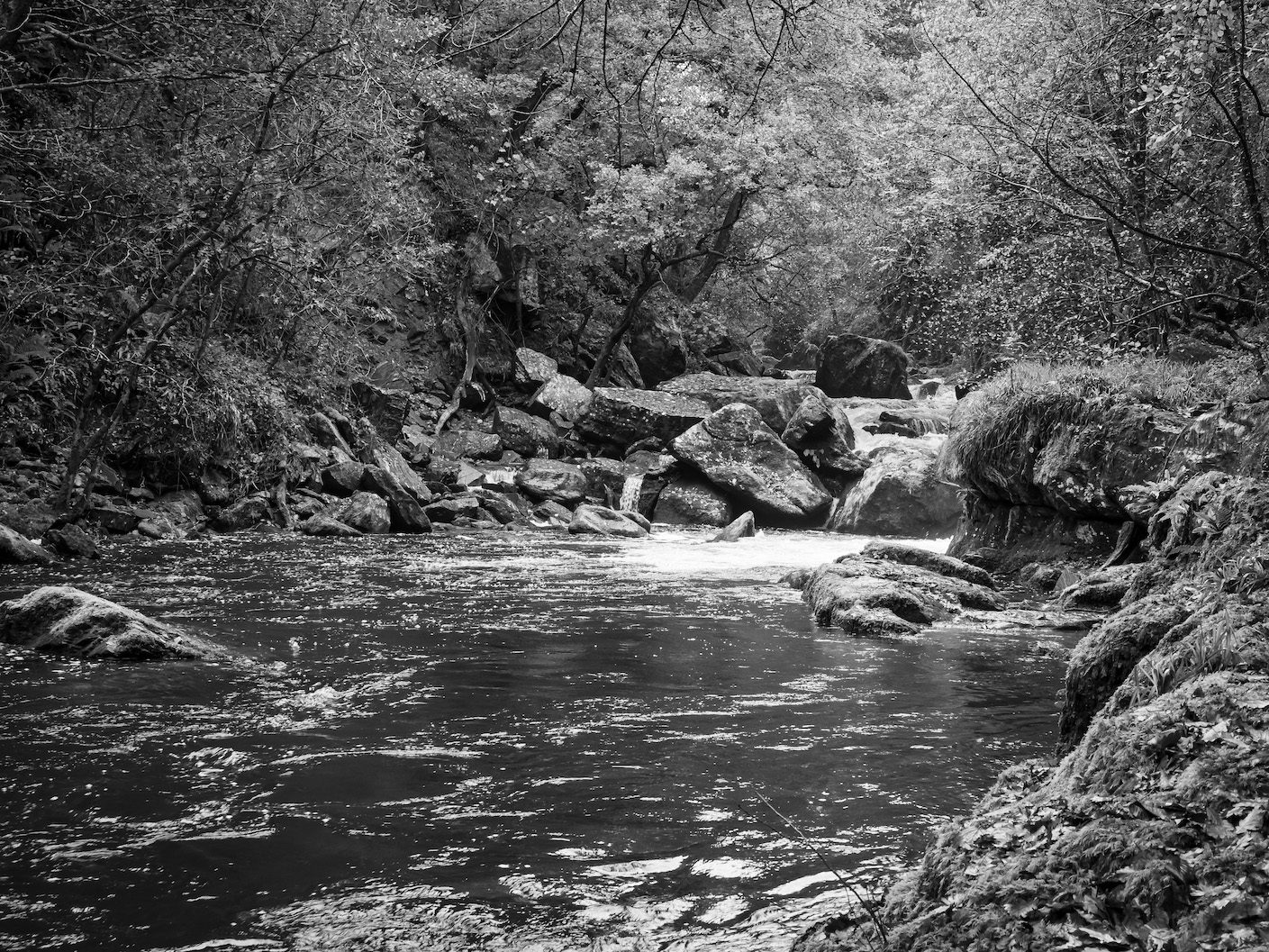
Inspired by tales of the past gleaned from old fishing books, the author sets out to fish those same waters, to cast the same flies on the same pools, to explore how fishing the streams of Exmoor might compare with fishing them over a century ago, whether those streams have changed and how they might be faring today. Exmoor rivers and streams appear pristine, barely changed since Claude Wade described them in his 1903 book Exmoor Streams, yet the numbers of trout he and other long-ago writers reported catching seem unbelievable today. Those streams must once have held an astonishing abundance of fish.
Modern problems affect even upland streams, yet many good folk are dedicated to their restoration and there is much we can do to help. River conservation work can be fascinating and rewarding as we develop a deeper understanding of river habitats through, for example, managing a balance of light and shade, monitoring aquatic invertebrates and cleaning riverbed spawning gravels then watching for their use when migratory salmon return home from the sea.
Those nail-booted, greenheart wielding fishermen of the past have gone but the streams still run on their wild ways, singing their endless songs to the moor. This book is for all who share concern for the wellbeing and conservation of our rivers and streams as well as those entranced by the rise of a trout to a well placed fly.
BRIGHT STREAMS OF MEMORY
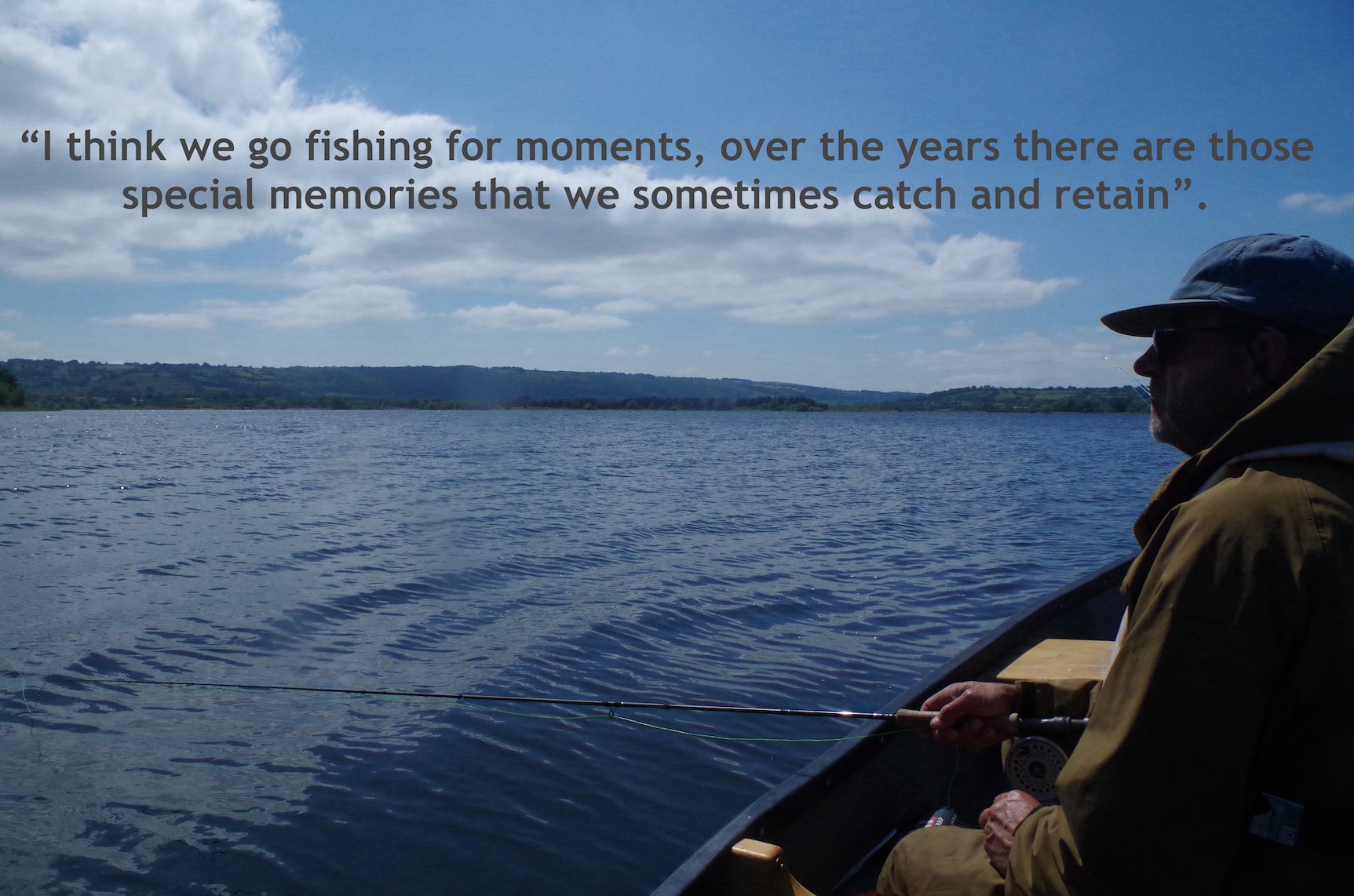
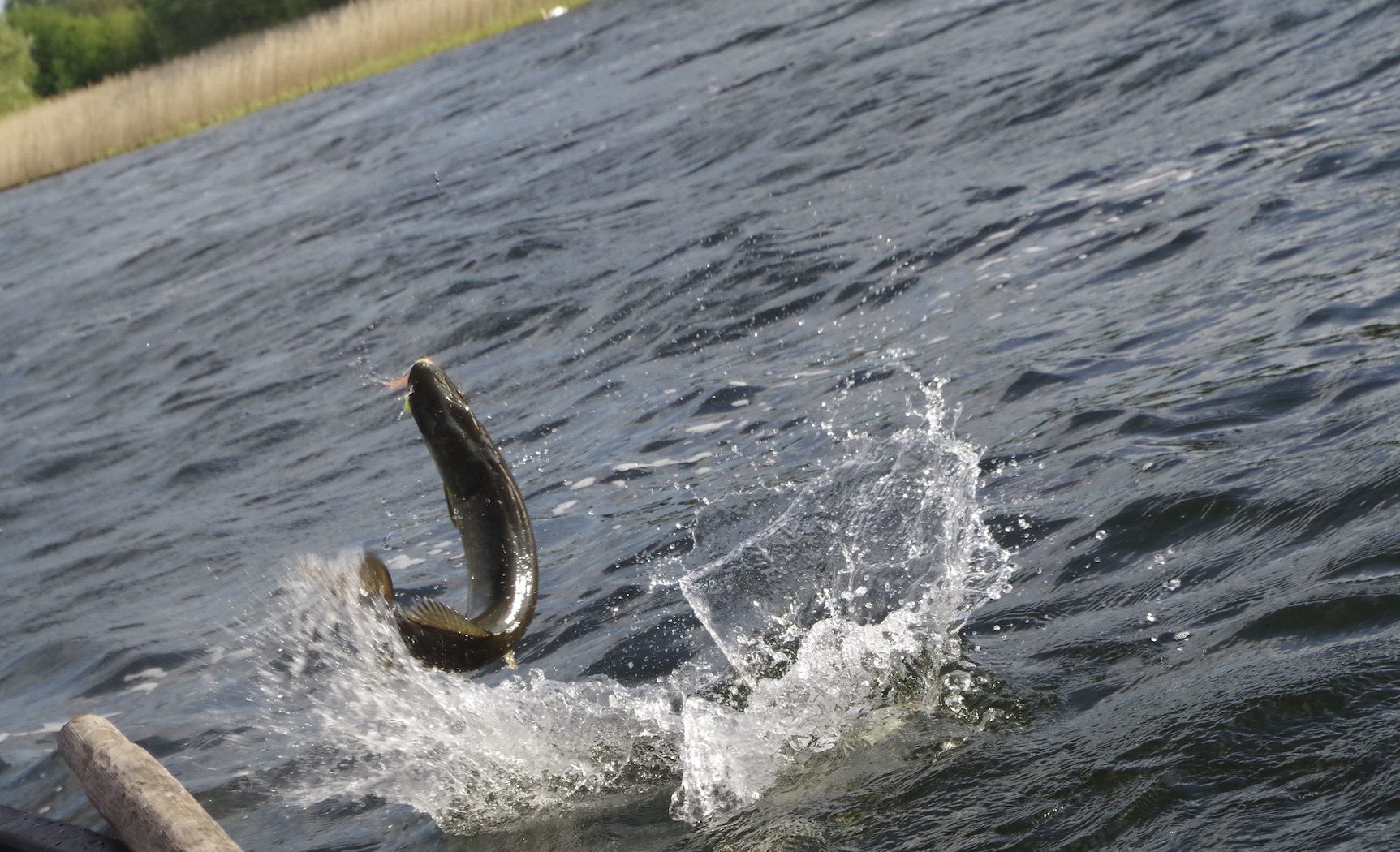
It had been a long day casting big flies for pike on the vast Chew Valley Lake in Somerset and we had just a few jacks to show for our efforts. We tramped back to the car and began to wearily sling the gear into the back of the vehicles. Should have played golf quipped Bruce, really! I replied in disdain. We both knew that we would have viewed such a day a waste of time. I commented that I am often asked by non-anglers why we go fishing as we only throw them back? I said I have given up trying to explain. Bruce paused and commented, “ I think we go fishing for moments, over the years there are those special memories that we sometimes catch and retain”.
This got me pondering as I drove home. At the time I was reading the classic tome “ Where the Bright Waters Meet”, written by Harry Plunket Green and first published in 1924. The previous night I had been reading of Blagdon Lake and the village of Blagdon.
“ But Blagdon itself will always remain one of the few places where the hand of man has improved on nature, bewitching in its beauty, with its Bavarian village, its purple sunsets, its nights with the thousand eyes, its kindly people, its virile sport and its blessed physical fatigue.”
Plunket enjoyed visits to the lake with his great friend H. T. Sheringham who also waxes lyrical about Blagdon in his book “ An Open Creel’ published in 1910. “ I have known rise from four-pounders missed because the angler was so busy admiring Blagdon Village, with its grey church tower and wealth of fruit blossom, and one cannot praise it more highly than by that confession.”
The words of Plunket and Sheringham drifted through my mind as I glanced down to the historic waters of Blagdon as I drove through the village and reflected upon my memories of Blagdon, those of the authors above and of Bruce’s words fishing for memories.
Through an angling life we do indeed gather memories and there not all directly related to special catches of fish. The places, the people and nature that surrounds are all embroidered into our minds eye.
Harry Plunket Greens classic book , “ Where The Bright Waters Meet” paints a generally tranquil picture of rural England and the quintessential Chalk streams that flow through peaceful villages. I wondered how much this had changed over a century and whether Plunkett would recognize his home village. Speaking to a fellow angler one evening he commented that little had changed in Hurstbourne Priors where Plunkett resided and fished the Bourne Rivulet all those years ago.
In early June Pauline and I arrived in the village of Longparish to explore the Test Valley and perhaps get a glimpse of Plunket’s England. A day’s fishing on the Test and its tributaries is prohibitively expensive so any casting of the up-stream dry fly would be virtual.
The delightful thatched cottage we stayed in was a short walk from the Test and we enjoyed several walks to watch its waters flow. On our first afternoon walk we heard the timeless and evocative call of the cuckoo echoing across the water meadows. Mayfly were fluttering above the water, occasionally dimpling the surface. I watched as trout sipped them down in classic style. I imagined casting a dry fly to these trout and the delectable moment of deceit as the trout is hooked.
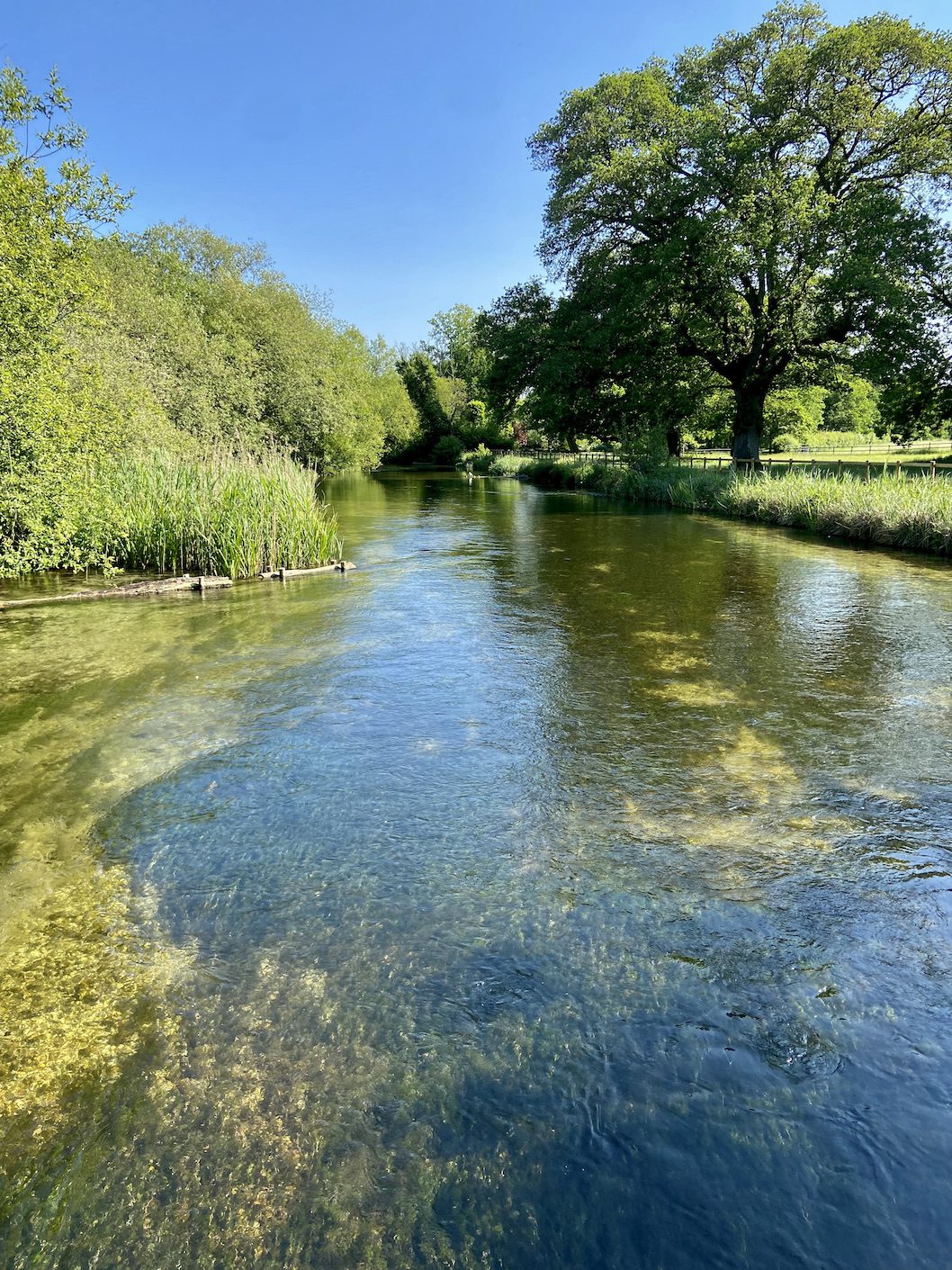
We set off early in the morning to walk from Longparish to Hurstbourne Priors where HPG lived from 1902 until 1912. “the little Hampshire Bourne, in those days unquestionably the finest small trout stream in England.” Plunket reflects upon his first visit.
“It was a gorgeous day without a breath of wind, and the smoke from the thatched cottages rose up in straight blue lines against the dark elms of the hill behind. The valley ran at right angles to the one we had come through , and in the middle of it lay the village in a golden sheet of buttercups under the beechwoods of the deer park there ran a little chalk stream clear as crystal and singing like a lark.”
“There was a church half hidden in the trees and the people were just coming out after the service, and there was an indescribable feeling of peace over the whole scene. It was a typical picture of English country Life which Constable might have painted or Gray have sung.”
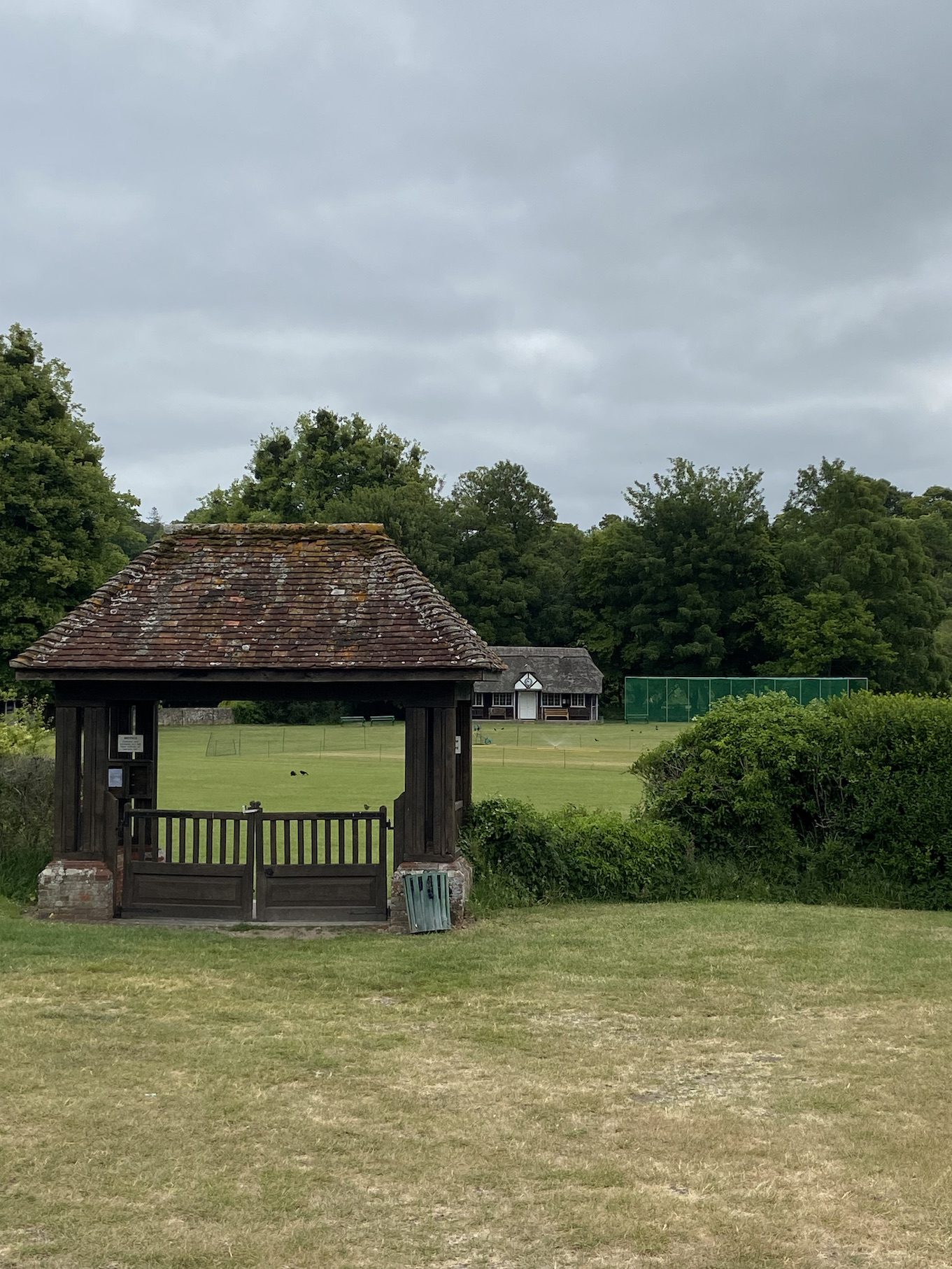
We walked a footpath across several fields on our way to Hurstbourne Priors. A red kite soared above the lush green valley and a hare bounded away from us as we disturbed its morning graze. We walked into Hurstbourne Priors and approached the centre of the village and paused at the entrance to the Cricket pitch looking across to the church partially hidden amongst the lush green trees of early summer. The scene before us was one of reassuring continuity. We walked slowly across towards the Thatched Cricket Pavilion and sat upon one of the green benches placed to commemorate the Jubilee of King George V in 1935. There was also a bench commemorating the Silver Jubilee of Queen Elizabeth 11 1952 to 1977.
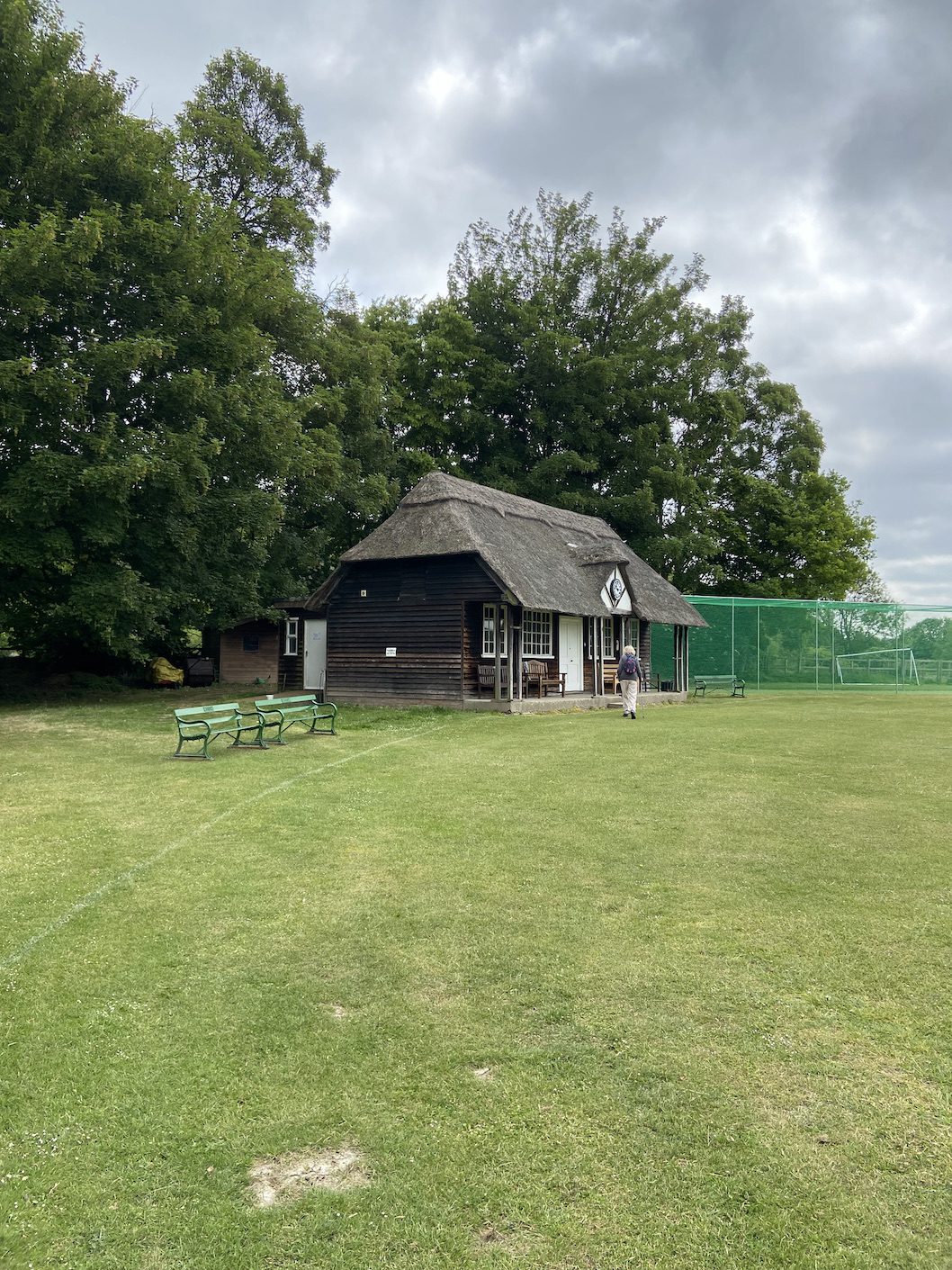
We sat for a while soaking in the timeless vista. Swallows swooped low over the wicket and rooks paced upon the closely mown grass searching for worms. Harry Plunket Green was a keen Cricketer and includes reminisce about Cricket in his book and the two cricket teams in the village. The Hurstbourne Priors Club and the Hurstbourne Park Club.
We noted the notice in the club house window; Hurstbourne Priors Cricket Club is a friendly village club with a long history and is seeking to recruit and welcome new members. Looking out across the pitch It was apparent that little had changed since 1911 when Harry Plunket spent most of the summer playing cricket.
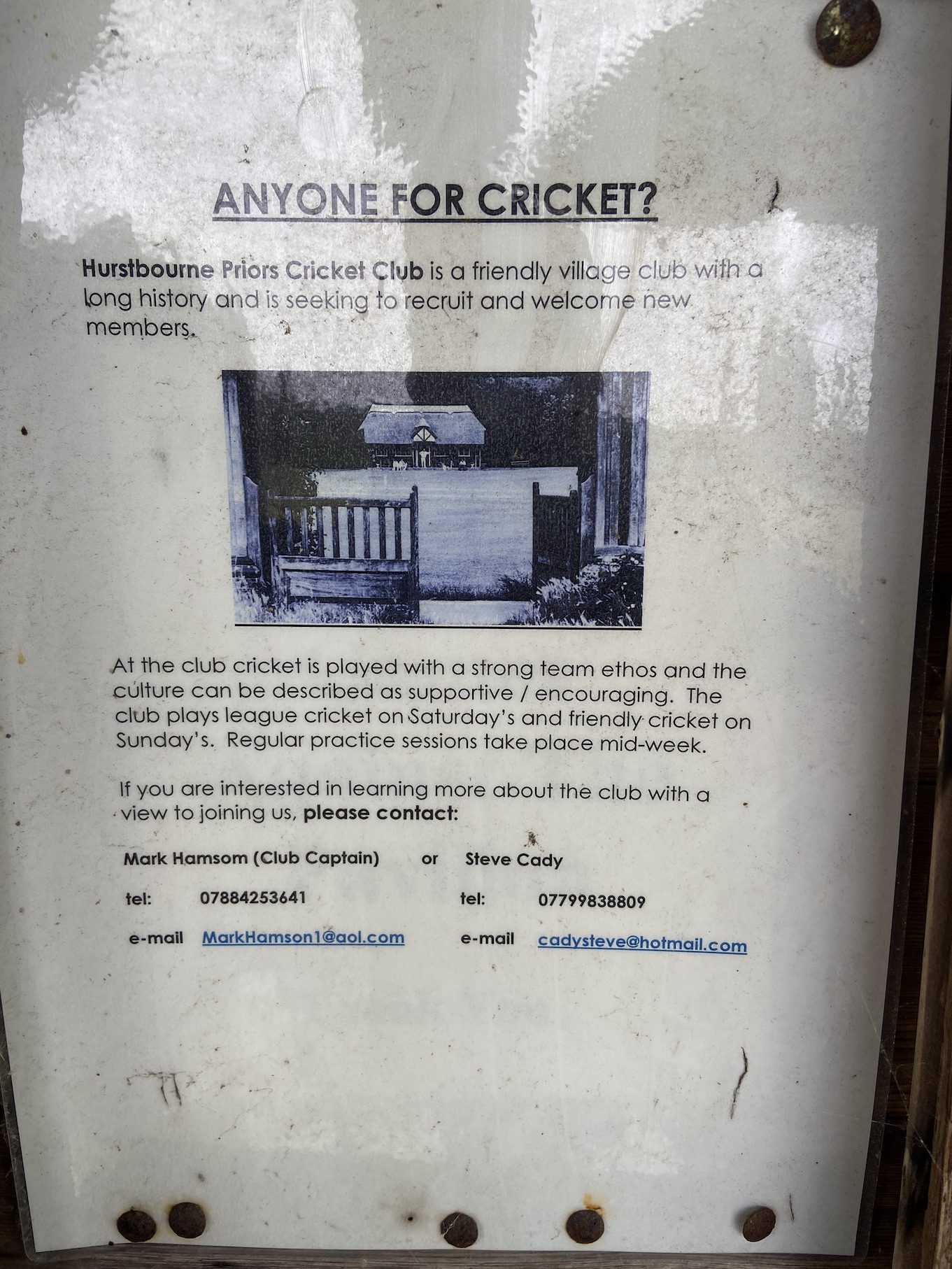
A path lead from the Cricket ground directly into the church yard where we hoped to locate the resting place of Harry Plunket Green. Ancient Yews grew within the grounds and it was pleasing to imagine the tranquil waters of the Bourne Rivulet just a few yards away hidden from view amongst the lush green growth of early June.
After a while strolling around the historic grave stones, We found a cross and at its base the inscription
HARRY PLUNKET GREENE
SINGER
1865 – 1936
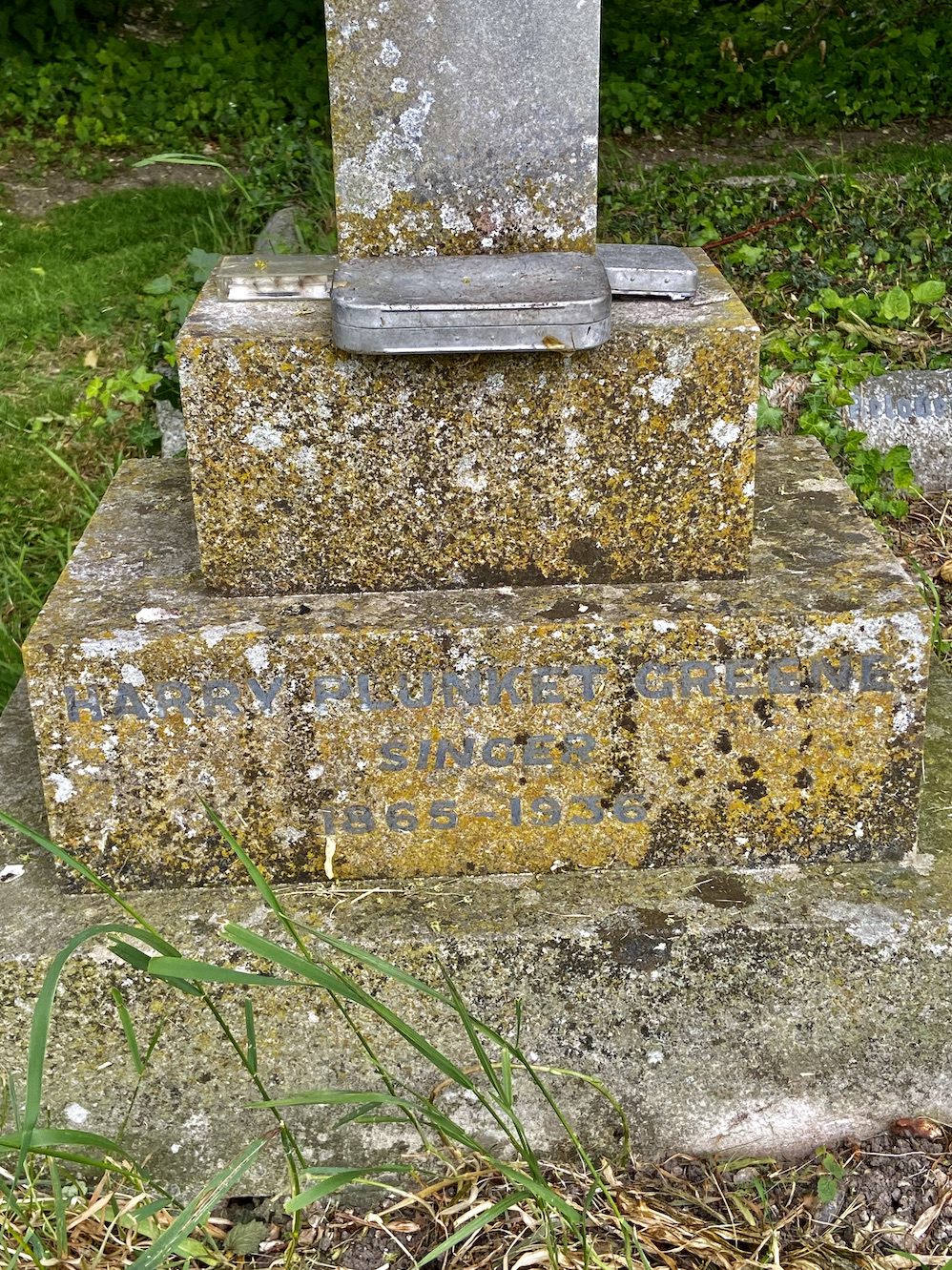
Placed upon the grave stone were poignant boxes of old rusty flies left by anglers paying homage to a man who had shared his treasured memories and thoughts from a time now long since passed. High up on the lichen encrusted stone I found a recently deceased mayfly that seemed to symbolise the spirit of those bright waters. Harry Plunket Greens resting place is perfectly located between those bright waters that still sing like a lark and those mowed greens where leather meets willow on long summer days and evenings.
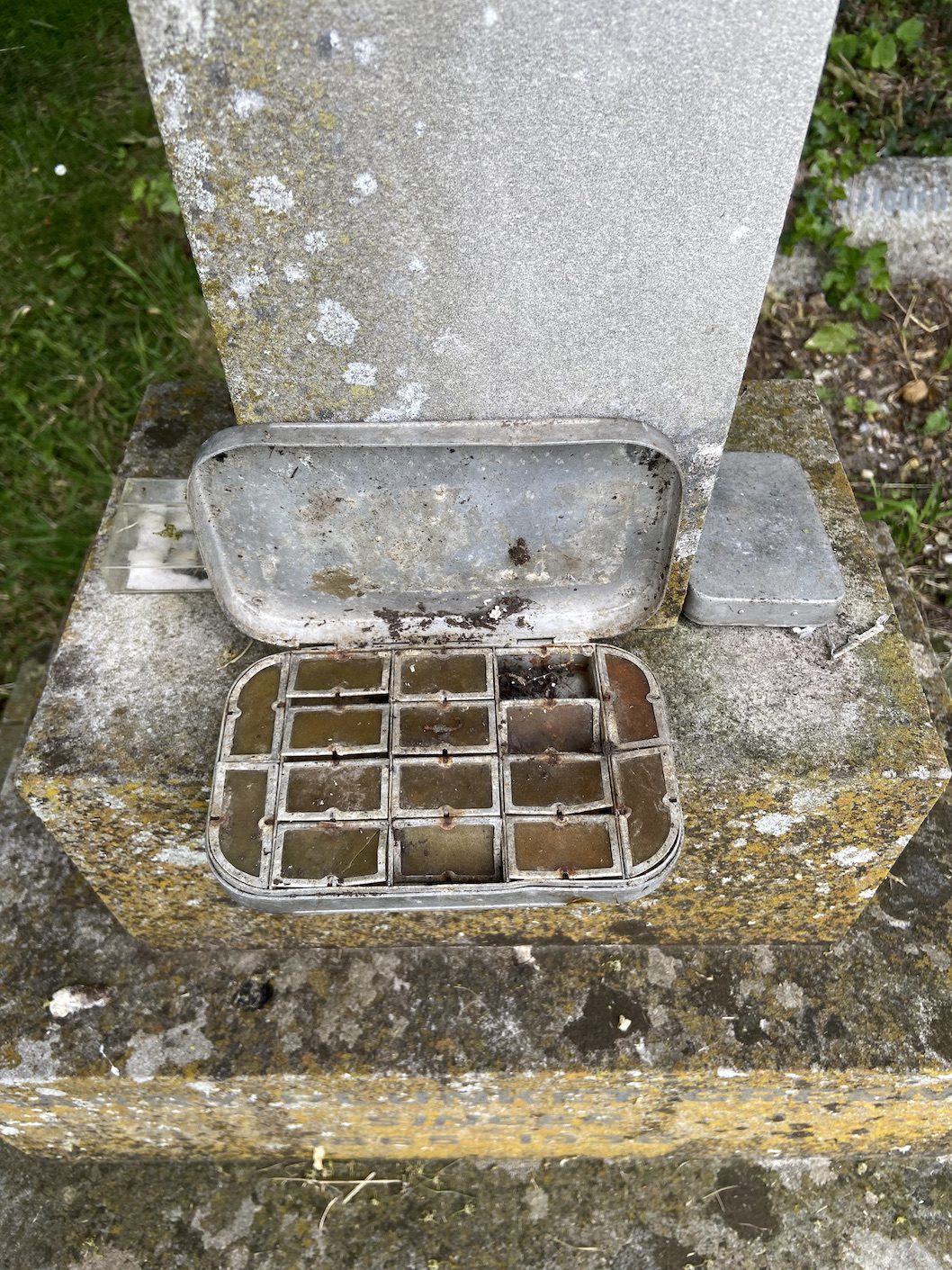
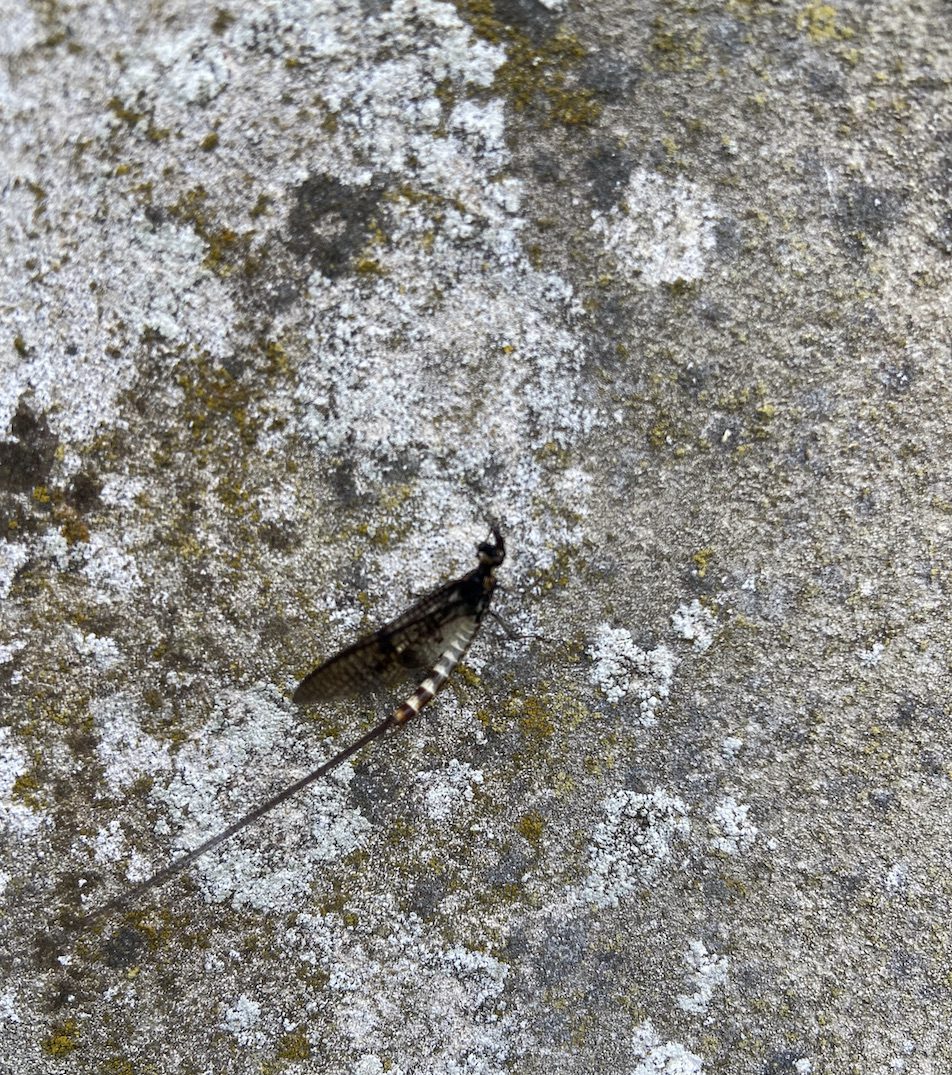
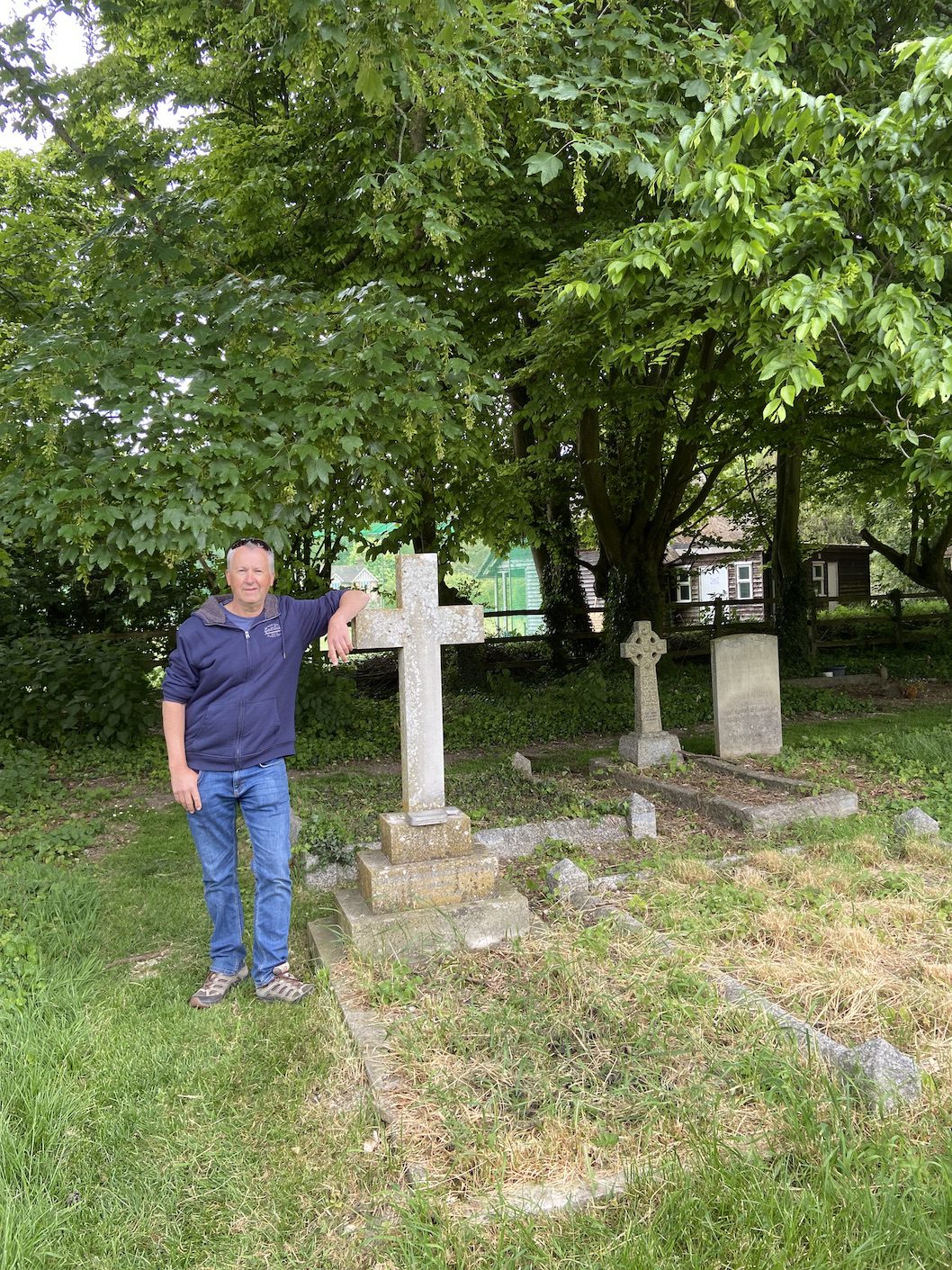
Harry Plunket Greene was a renowned singer of his time and toured Europe. He was Professor at the Royal Academy of Music (1911-19) and the Royal College of Music (1912). When he retired from teaching he devoted more time to writing about music and his passion, Fly Fishing. He was a member of the MCC, and president of the Incorporated Society of Musicians in 1933.
Later that afternoon we visited the village of St Mary Bourne close to where the Bourne Rivulet rises and wandered along the gin clear stream that passes through another delightful old English village of chocolate box thatched houses of red brick decorated with rambling roses of red, pink, gold and yellow.
The following day we headed to the National Trust property of Mottisfont. Its grounds border the River Test and its tributaries. Beside the Abbey Brook is a hut apparently used by the grandfather of Dry Fly Fishing F M Halford whose forthright and at times dogmatic views stimulated heated debate with G E M Skues who preached upon the effectiveness of the Upstream nymph. Halfords book ‘Dry Fly Fishing-in theory and practice’ published in 1889 still influences the anglers who fish the Test a century later.
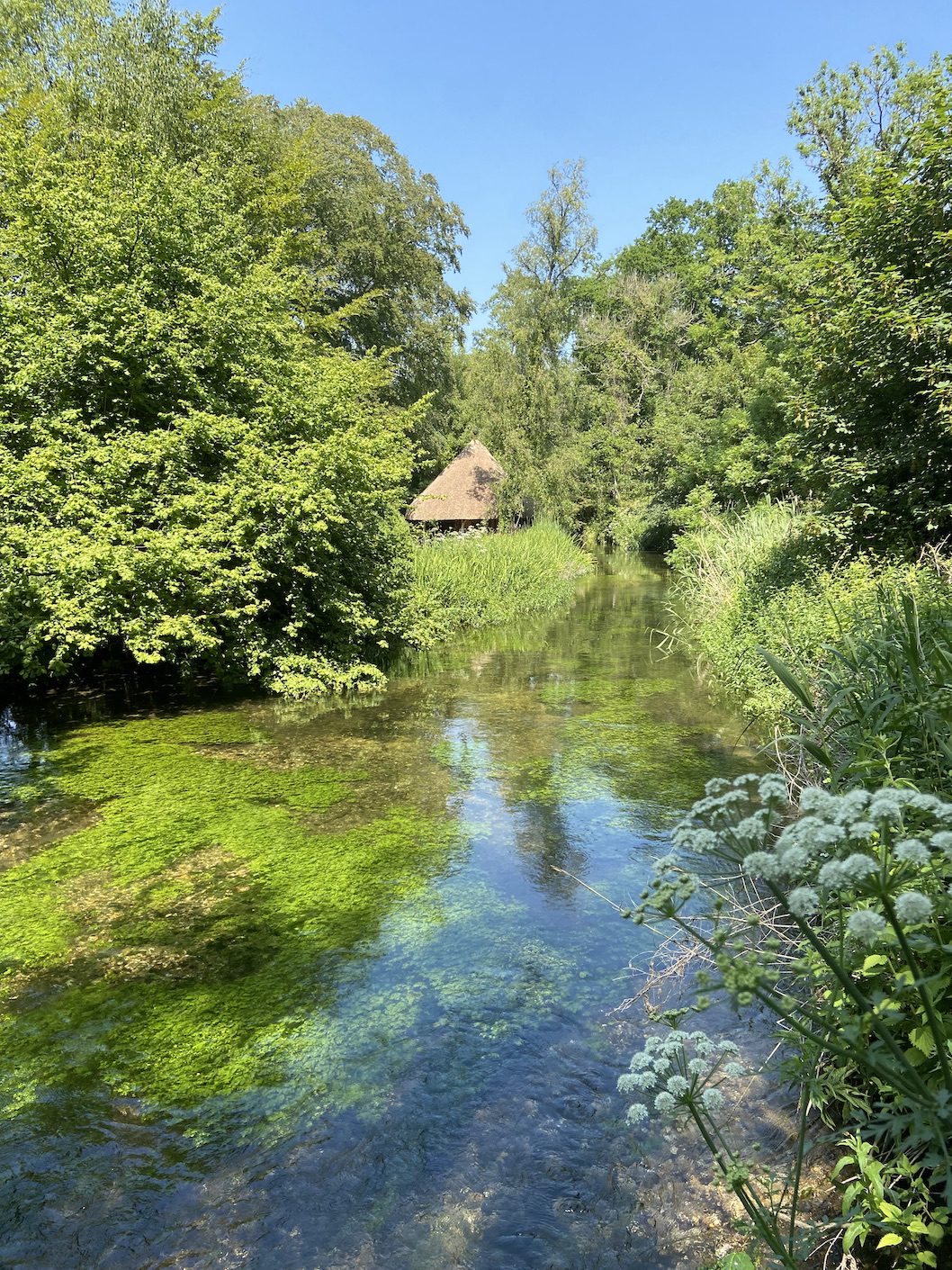
We walked the river within the grounds of Mottisfont and gazed into those clear waters glimpsing a wide variety of fish. Not just large trout but specimen roach, grayling and perch. These tranquil waters with lush beds of ranuculus and clean gravel are undoubtedly the Fly Fishing equivalent to Lords Cricket ground. The strict rules of etiquette introduced by Halford’s doctrine have refined the art of fly fishing effectively making the catching of trout more enjoyable and rewarding.
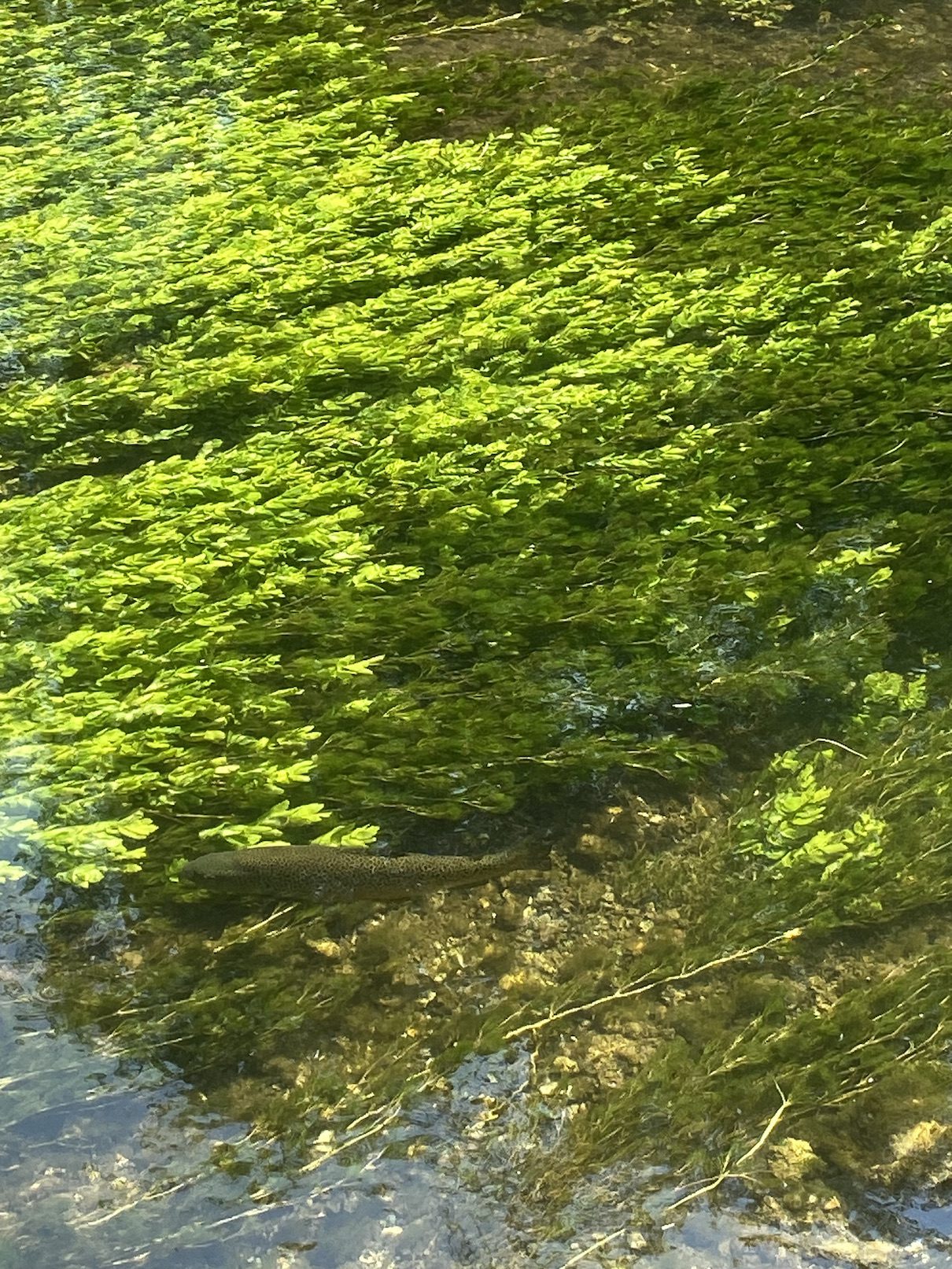
On our last day in Hampshire, we headed for Stockbridge where it was easy to linger in a High Street punctuated by clear waters of the Test as they flowed through the small town. A tower in the heart of the town carries a golden trout weather vane. Swifts gyrated around it screeching their sound of high summer.
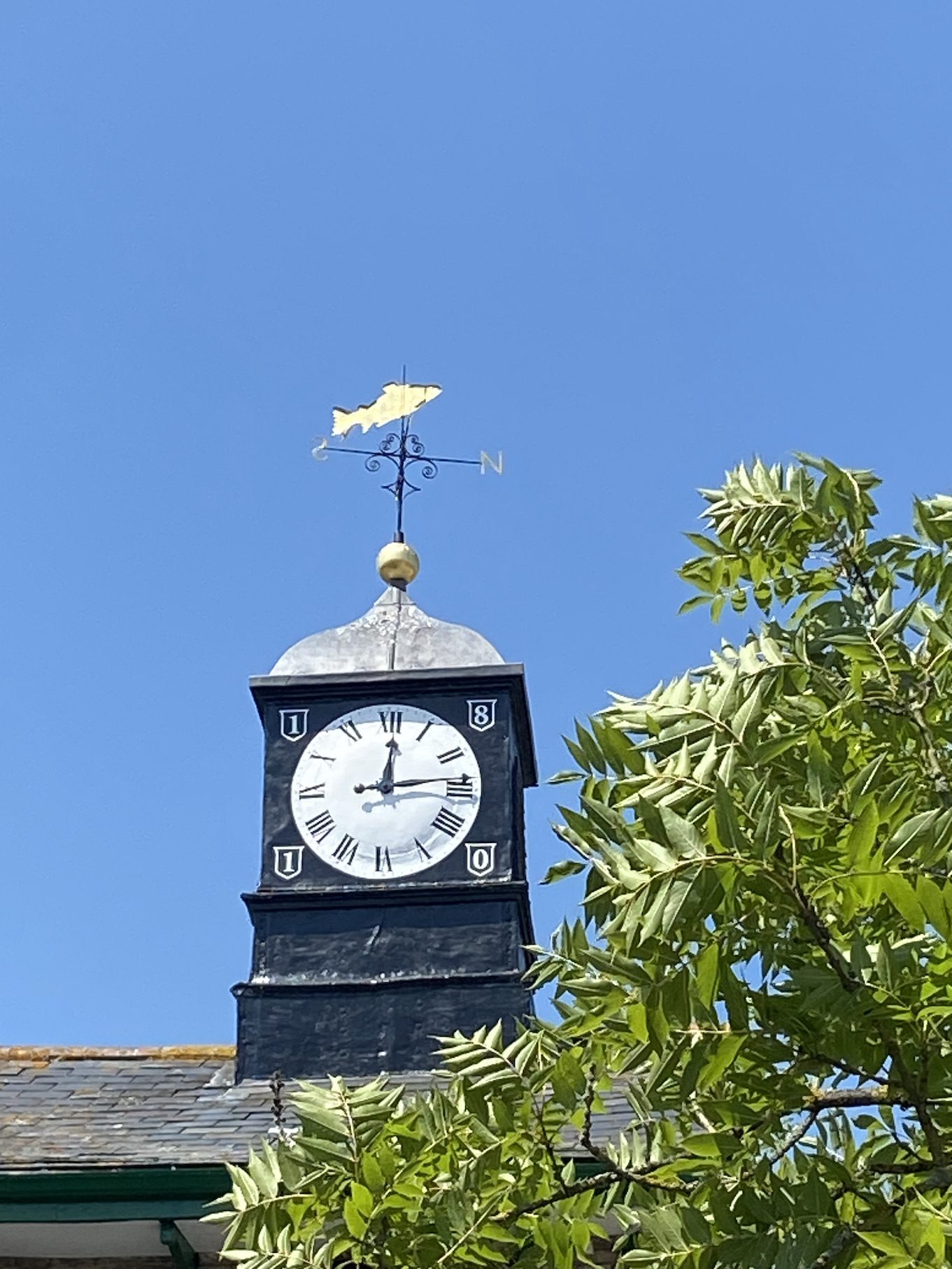
Two fine tackle shops sit either side of the High Street the last remaining Orvis Outlet store and ROBJENTS of Stockbridge. Both game fishing shops carry a wealth of fly fishing equipment and clothing. I chatted for a while with those in both shops and left feeling optimistic for the future of fly fishing despite many issues that blight our world.
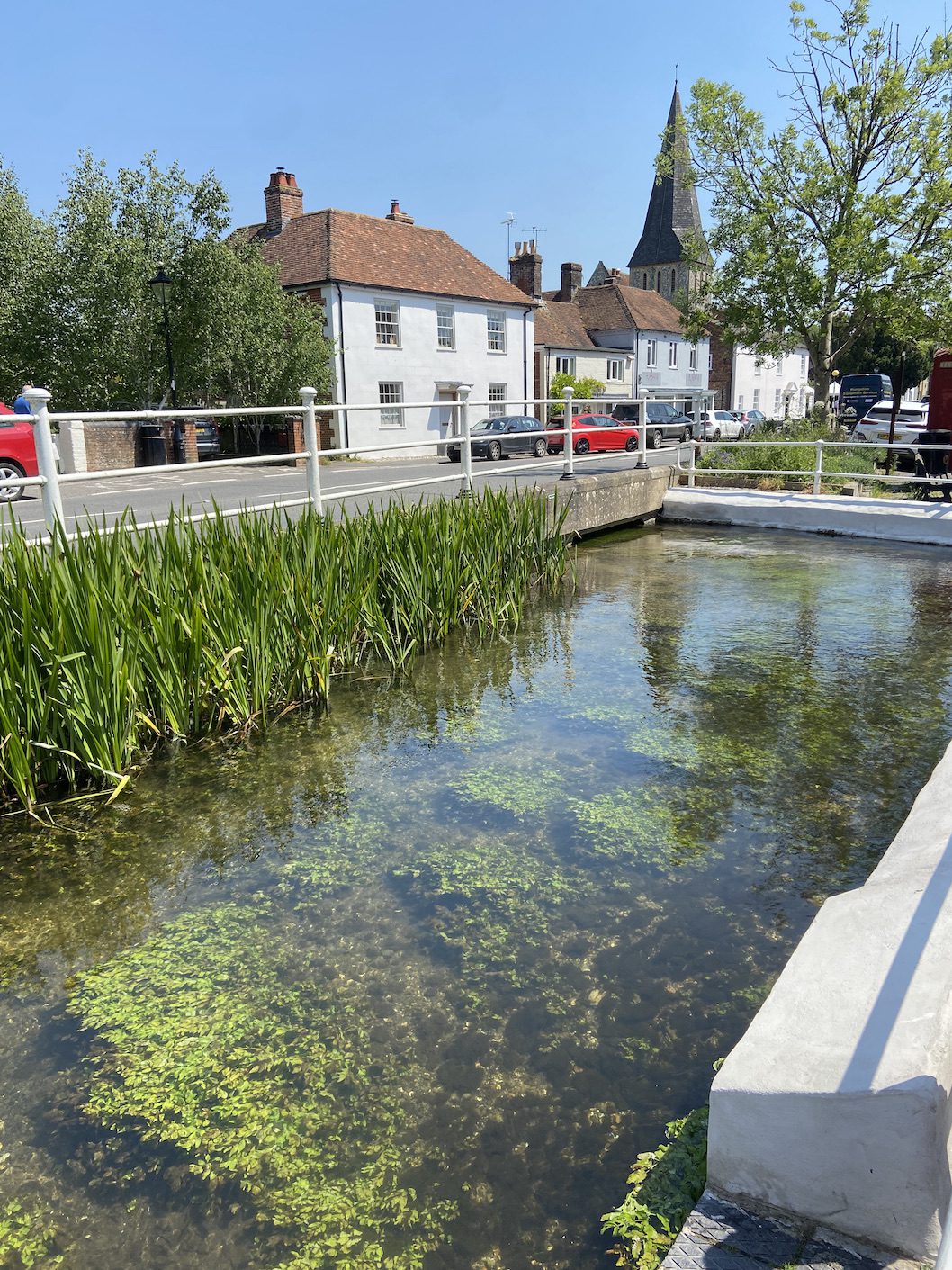
We leave Stockbridge to walk the water meadows below the town. These havens for wildlife flank the Test and once again I relished the art of virtual fly fishing flicking an imaginary dry fly or upstream nymph. I spotted some beautiful thick bodied trout in the main river. A cuckoo’s summer song drifted across the buttercups and the river lined with water hemlock and yellow flag Iris.
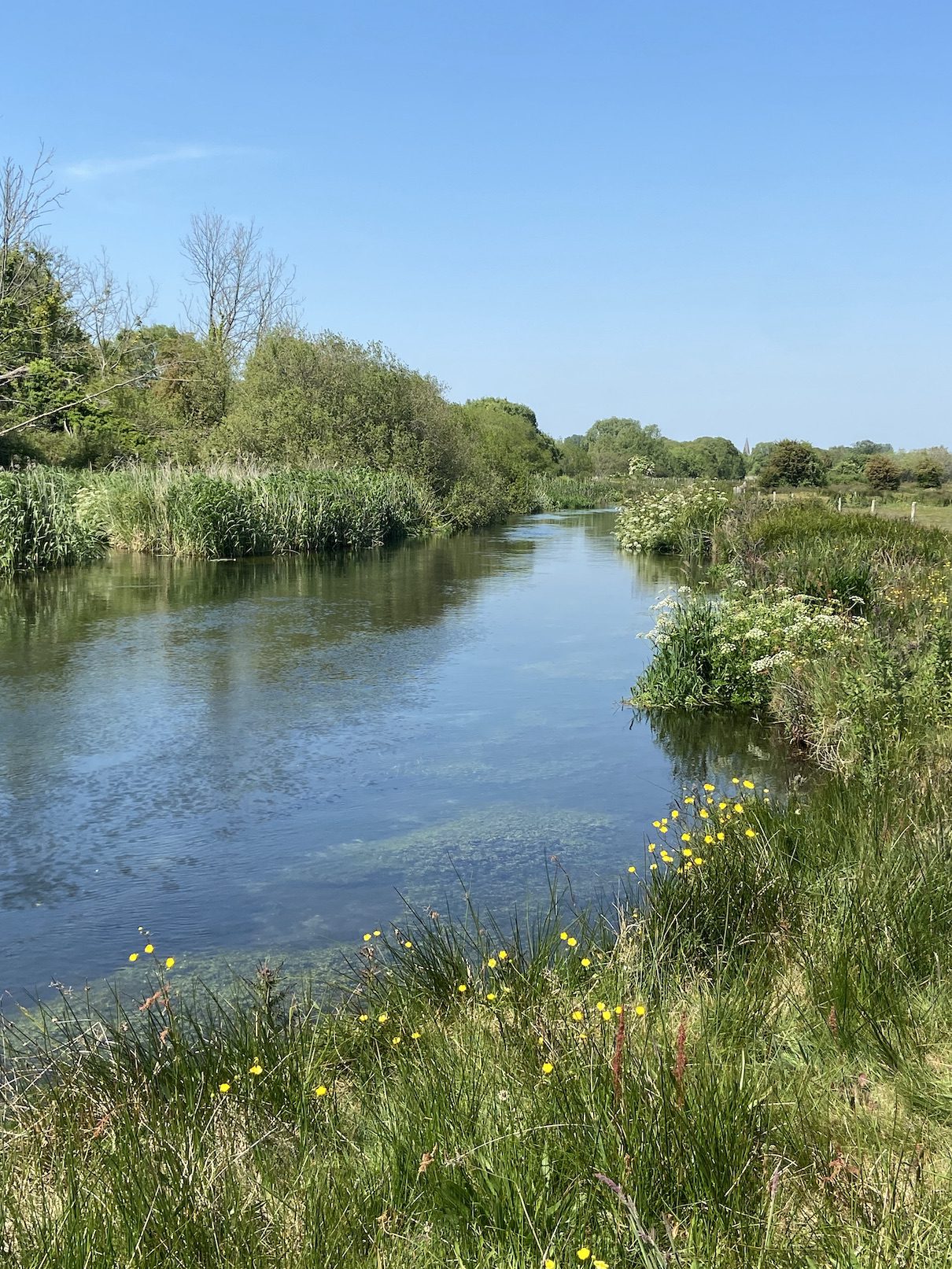
We stopped for afternoon tea and coffee beside a small carrier stream the small brown trout clearly visible in the gin clear waters illuminated by the bright sunshine. I watched these small trout and remembered the wild browns of the tiny River Umber in North Devon where my lifelong love of fishing started.
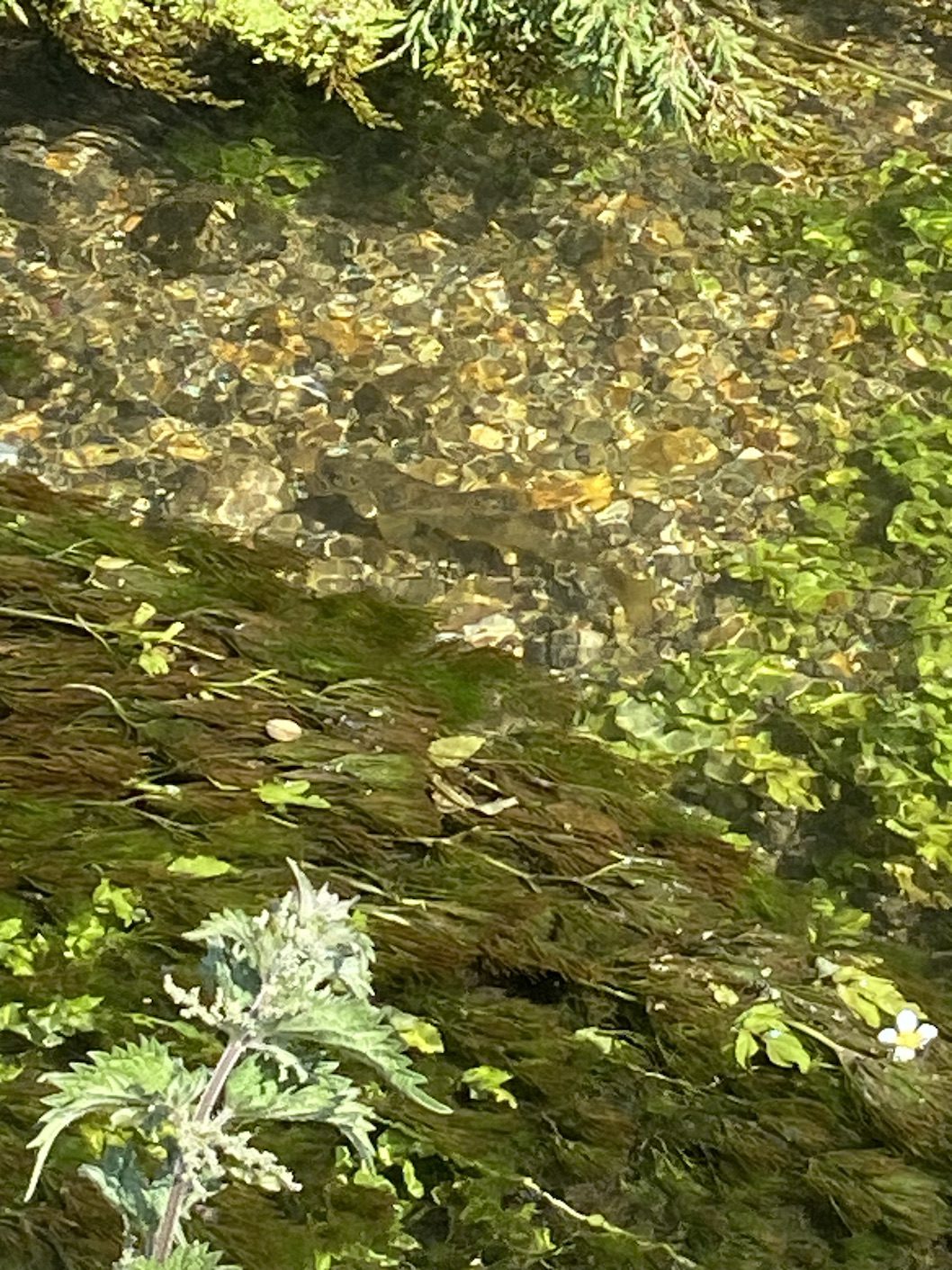
The revered waters of the Test are famous throughout the world in parts manicured and stocked whilst other beats still hold wild and wily trout. Whilst all is not perfect it is perhaps to be noted that this corner of England seems to have retained a certain tranquil charm that is to be treasured. Those privileged to live and fish and walk these banks have in part due to wealth and nimbyism protected the worlds of Harry Plunket Green and F M Halford. And ensure that generations continue to fish for memories be it virtual or real.
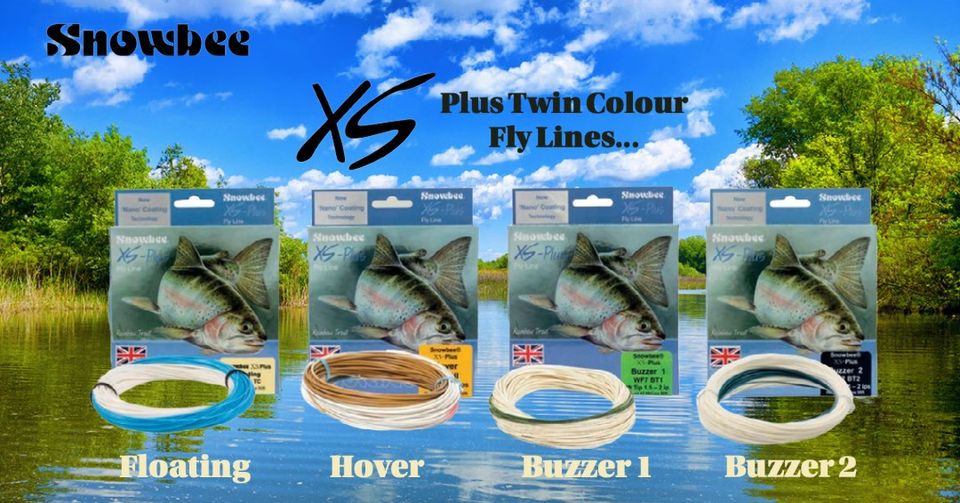
WHERE ARE ALL THE CLIMATE DENIERS GOING?

Many thanks to Richard Wilson for allowing me to share his thought provoking prose on North Devon Angling News. This month Richard’s focus is climate change and the deniers and what we can for for our local rivers. For my part I spread the word and try to raise awareness of the threats to rivers from industrial farming, sewage discharge and over abstraction. I also undertake River Fly Monitoring, CSI Monitoring and volunteer with the National Trust assisting with wetland creation and conservation initiatives.
Where Are All the Climate Deniers Going?
Or: How to save your river.
Once upon a time, back in the day, just about all online mentions of global warming provoked CAPS LOCK outrage:
“HUMAN-CAUSED GLOBAL WARMING IS THE BIGGEST HOAX EVER FORCED ON OUR PEOPLE. IT HAS NEVER BEEN ABOUT GLOBAL WARMING. IT HAS ALWAYS BEEN ABOUT CONTROL. GLOBAL WARMING IS THE LIBERAL’S ULTIMATE VEHICLE FOR CONTROLLING EVERYTHING EVERYONE DOES.” 1
My response to this sort of behaviour has been to hunker down. I don’t want to be heckled – who does? So I’ve been watching from a safe distance … and I think I’ve spotted a change in key-banger behaviour. Maybe you’ve noticed it too?
I wonder if they’re going a bit droopy – like that toy rabbit on TV with the wrong brand of battery? I’m talking sotto voce for now because I don’t want to wake them, but do you think they’re getting – old?
Musk has turned their Twitter volume up to 12, which hides some of the decrepitude, but it’s increasingly clear that a generation is thinning out. Back in their pomp they stood proud among friends, bonding over beers and howling at bogeymen. It was fun, the company was good and they felt like an unstoppable force. The world was theirs for the taking. Heck, they could even get laid. Those were days!
Then, over time, the group frayed and faded. Familiar faces moved away, some died and a lucky few retired to sunbeds by the sea. Now, depressingly, the headlong rush of young lust is a dim memory, and wearily beating a caps lock key won’t bring it back. Age has got their number.
So while I think we should feel some sympathy towards our denialists (we all get old), we should not be surprised by their plight. They are the original stay-at-home globalists, persecuted by malign world forces. This miserable everybody-hates-me-nobody-loves-me mindset also happens to be the signature trait of almost all conspiracy theories, so people who buy into one are predisposed to have a bucketful. If you know for a fact that George Soros and his glove puppet Greta can fake all the climate data everywhere, you also know that wherever you stash your cash The Global Elite will sniff it out (it happens all the time!).
It’s carnage out there in conspiracy land: Innocent bystanders are killed by 5G death rays, chemtrails, vaccines and fluoridated water, or abducted and raped by both real and false-flag aliens. The last generation of conspiracists had scary Reds under their beds and would be horrified to learn that today’s have Reds in their heads. Stalin was satan, Putin is a buddy, Kennedys won’t die and some Americans want a breakaway Red State Caliphate. I hope you’re keeping up.
Then there’s The Fear:
“GLOBAL WARMING/CLIMATE CHANGE, CALL IT WHAT YOU WANT. IT'S YET ANOTHER WAY FOR THEM TO FEAR-MONGER AND REDISTRIBUTE WEALTH.” 1
In contrast, statistics and fact-checking are inherently dull – but they can make a succinct point 2&3. Globally, most people believe that climate change is both a crisis and an emergency, echoing the language used by climate change campaigners. In the US, about 80% say climate change is happening, outnumbering those who think it isn’t by a ratio of more than six to one. In the UK, 90% think it’s real. And another fact: 99-100% of climate scientists say it’s real and deadly serious. That’s a slam dunk (for people who do facts – but not so good with voodoo).
Other forces also conspire to undermine our deniers, not least their own eyes. There are only so many decades you can fish the same river and not notice something’s wrong. And is there anyone for whom freak weather isn’t the new normal? So, according to the liberal wokesters at Forbes, hardcore denialist numbers have fallen to just 6% of Americans, which is still well above the global average of 4%. All of them hammering away at Twitter. Thanks again, Elon.
This climate data is, of course, all red-mist-inducing heresy for our remaining jihadi denialists, for whom an attack of heresy-rage is about as exciting life gets.
“THE DEPARTMENT OF DEFENSE SAYS THAT ‘GLOBAL WARMING’ IS A ‘NATIONAL SECURITY THREAT’. WHAT A JOKE. ANY EXCUSE TO STRIP CITIZENS OF RIGHTS.” 1
It’s a level of victimhood that‘s a hard sell among younger generations. More youthful movements offer rewards like happiness, cupcake recipes, glowing good health, a ripped body or, in Gwyneth Paltrow’s case, fragrant orgasms. Tik-Tok thrills mostly meet educated opinions. In contrast, conspiracy theories are gloom, doom and misery. Incels excepted, who’d double-click on that?
Back in my world, climate science is fact-based, measurable, progressive and has an off-ramp. We can slow down and change course. And for the hard-core miserabilists, all is not lost. You can also get utterly despondent about the science of global warming. The so-called climate-doomersprobably outnumber the deniers by a lot, and I suspect their roll-over and die mentality is as damaging to planetary well-being as the cranky deniers. Maybe there’s some misery-laden itch deep in the human psyche that we’re desperate to scratch?
Nevertheless, I’m going to puncture the glum-fest because we can do something about climate change. There is salvation in the denialist’s climate heresy.
Here’s how: There’s no shortage of great organisations committed to mitigating the impacts of climate change. Some of these actions need the power and deep pockets of government, while others are small and local. That means there’s a level of contribution to suit us all. We can volunteer &/or donate, big or small and as best we can. For example, I support organisations that work on conservation and legal protection for rivers and their catchments. And because most of us think this is now urgent, most of us can surely do something, no matter how small, because every little bit counts.
So, please, let’s all get involved. And let’s do it for our future generations because they’re going to have to live here. Maybe Gramps and Grandma will donate if it’s for their favourite river and their own family? Would their peer group really cancel them if they funded some research into migratory fish?
And last, please say hi to Gen Z and the Millennials. It’s their planet now.
I have a request: Who do you donate to or volunteer for? Feel free to give your favourite good causes a plug in the Comments below … let’s share some constructive actions and tell the kids we care. Good ideas are infectious, so let’s spread some.
FYI, I donate to The Atlantic Salmon Trust and Fish Legal. And I make losing bids in lots of good-cause raffles ….

